

High School Essay
High school essay generator.
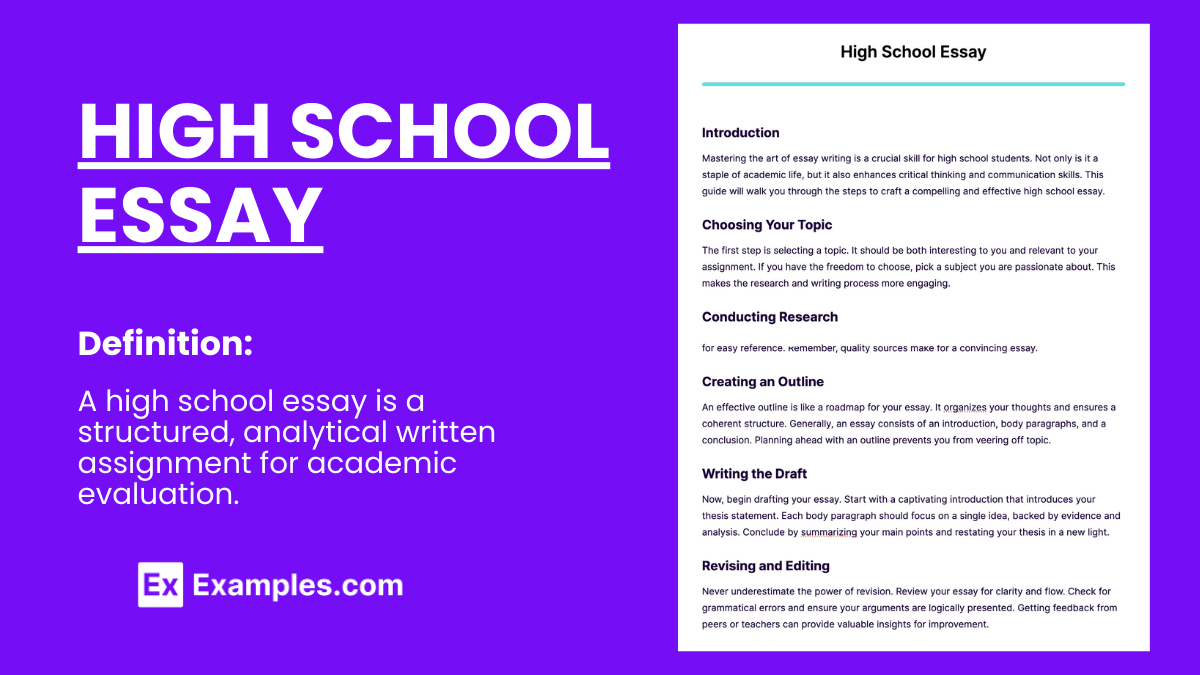
Navigating the complexities of High School Essay writing can be a challenging yet rewarding experience. Our guide, infused with diverse essay examples , is designed to simplify this journey for students. High school essays are a crucial part of academic development, allowing students to express their thoughts, arguments, and creativity. With our examples, students learn to structure their essays effectively, develop strong thesis statements, and convey their ideas with clarity and confidence, paving the way for academic success.
What Is a High School Essay? A high school essay is anything that falls between a literary piece that teachers would ask their students to write. It could be anything like an expository essay , informative essay , or a descriptive essay . High school essay is just a broad term that is used to describe anything that high school student writes, probably in subjects like English Grammar or Literature.
It is a good way to practice every student’s writing skills in writing which they might find useful when they reach college. Others might even be inspired to continue writing and take courses that are related to it.
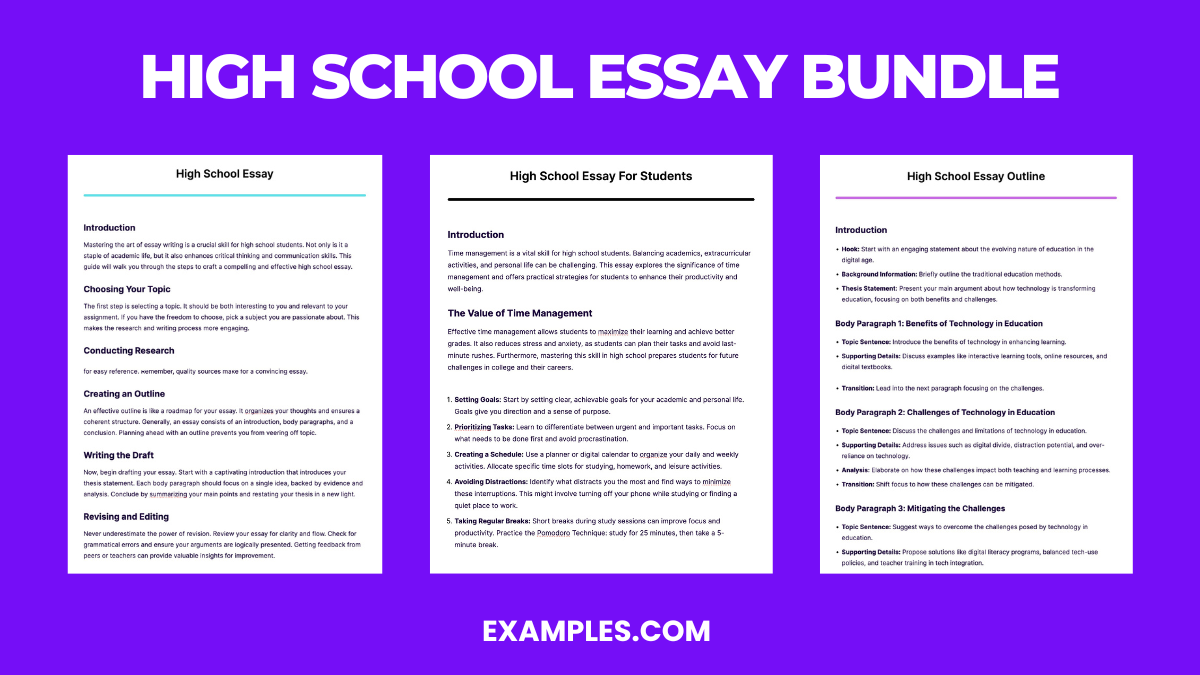
Download High School Essay Bundle
When you are in high school, it is definite that you are expected to do some write-ups and projects which require pen and paper. Yes. You heard that right. Your teachers are going to let you write a lot of things starting from short stories to other things like expository essays. However, do not be intimidated nor fear the things that I have just said. It is but a normal part of being a student to write things. Well, take it from me. As far as I can recall, I may have written about a hundred essays during my entire high school years or maybe more. You may also see what are the parts of an essay?
High School Essay Format
1. introduction.
Hook: Start with an engaging sentence to capture the reader’s interest. This could be a question, a quote, a surprising fact, or a bold statement related to your topic. Background Information: Provide some background information on your topic to help readers understand the context of your essay. Thesis Statement: End the introduction with a clear thesis statement that outlines your main argument or point of view. This statement guides the direction of your entire essay.
2. Body Paragraphs
Topic Sentence: Start each body paragraph with a topic sentence that introduces the main idea of the paragraph, supporting your thesis statement. Supporting Details: Include evidence, examples, facts, and quotes to support the main idea of each paragraph. Make sure to explain how these details relate to your topic sentence and thesis statement. Analysis: Provide your analysis or interpretation of the evidence and how it supports your argument. Be clear and concise in explaining your reasoning. Transition: Use transition words or phrases to smoothly move from one idea to the next, maintaining the flow of your essay.
3. Conclusion
Summary: Begin your conclusion by restating your thesis in a new way, summarizing the main points of your body paragraphs without introducing new information. Final Thoughts: End your essay with a strong closing statement. This could be a reflection on the significance of your argument, a call to action, or a rhetorical question to leave the reader thinking.
Example of High School Essay
Community service plays a pivotal role in fostering empathy, building character, and enhancing societal well-being. It offers a platform for young individuals to contribute positively to society while gaining valuable life experiences. This essay explores the significance of community service and its impact on both individuals and communities. Introduction Community service, an altruistic activity performed for the betterment of society, is a cornerstone for personal growth and societal improvement. It not only addresses societal needs but also cultivates essential virtues in volunteers. Through community service, high school students can develop a sense of responsibility, a commitment to altruism, and an understanding of their role in the community. Personal Development Firstly, community service significantly contributes to personal development. Volunteering helps students acquire new skills, such as teamwork, communication, and problem-solving. For instance, organizing a local food drive can teach students project management skills and the importance of collaboration. Moreover, community service provides insights into one’s passions and career interests, guiding them towards fulfilling future endeavors. Social Impact Secondly, the social impact of community service cannot be overstated. Activities like tutoring underprivileged children or participating in environmental clean-ups address critical societal issues directly. These actions not only bring about immediate positive changes but also inspire a ripple effect, encouraging a culture of volunteerism within the community. The collective effort of volunteers can transform neighborhoods, making them more supportive and resilient against challenges. Building Empathy and Understanding Furthermore, community service is instrumental in building empathy and understanding. Engaging with diverse groups and working towards a common goal fosters a sense of solidarity and compassion among volunteers. For example, spending time at a senior center can bridge the generational gap, enriching the lives of both the elderly and the volunteers. These experiences teach students the value of empathy, enriching their emotional intelligence and social awareness. In conclusion, community service is a vital component of societal development and personal growth. It offers a unique opportunity for students to engage with their communities, learn valuable life skills, and develop empathy. Schools and parents should encourage students to participate in community service, highlighting its benefits not only to the community but also in shaping responsible, caring, and informed citizens. As we look towards building a better future, the role of community service in education cannot be overlooked; it is an investment in our collective well-being and the development of the next generation.
Essay Topics for High School with Samples to Edit & Download
- Should schools have dress codes?
- Sex education in middle school
- Should homework be abolished?
- College education costs
- How does technology affect productivity?
- Is climate change reversible?
- Is social media helpful or harmful?
- Climate change is caused by humans
- Effects of social media on youth
- Are men and women treated equally?
- Are professional athletes overpaid?
- Changes over the past decade
- Guns should be more strictly regulated
- My favorite childhood memory
- Religion in school
- Should we stop giving final exams?
- Video game addiction
- Violence in media content
High School Essay Examples & Templates
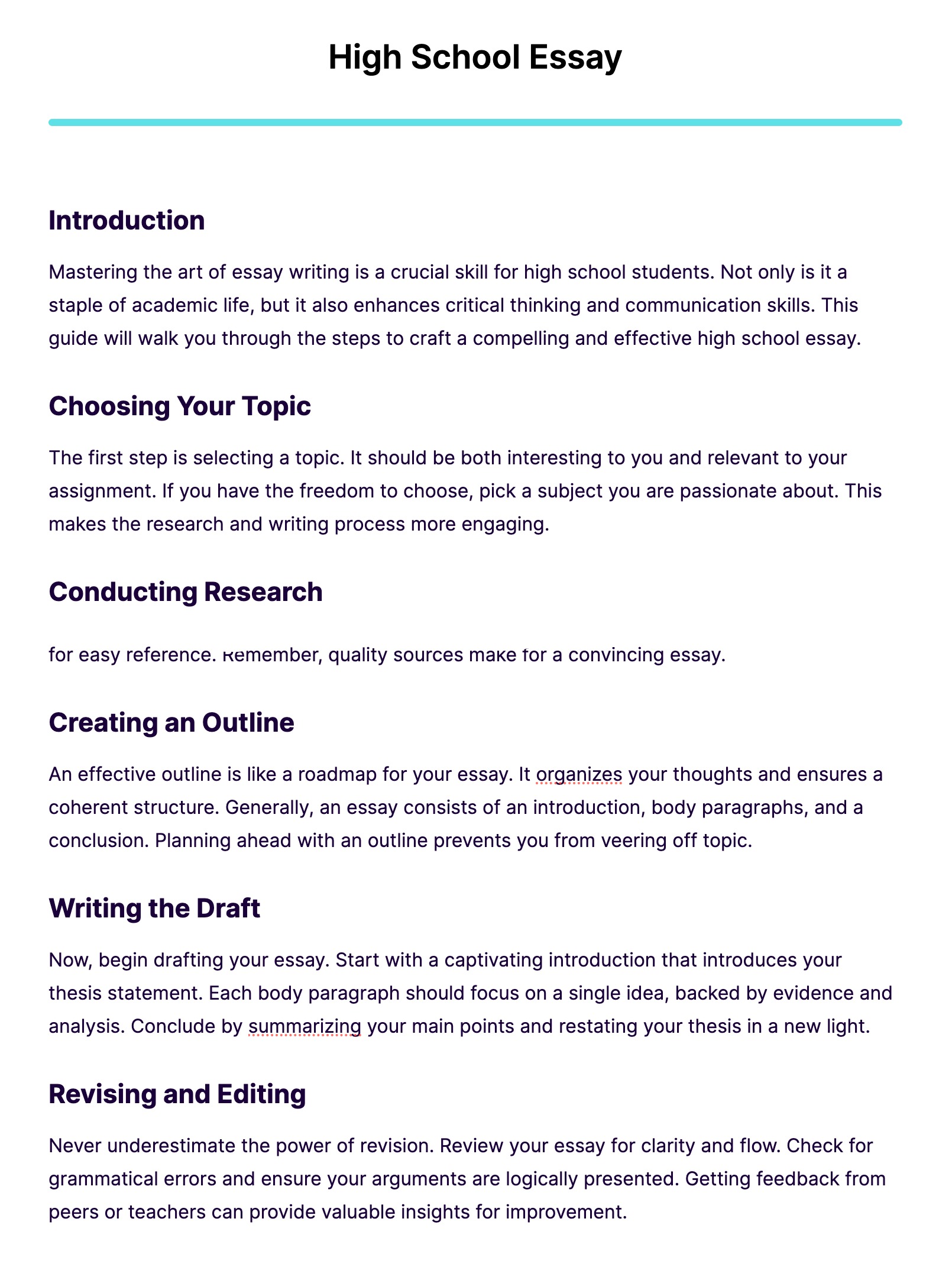
Free Download
High School Essay For Students
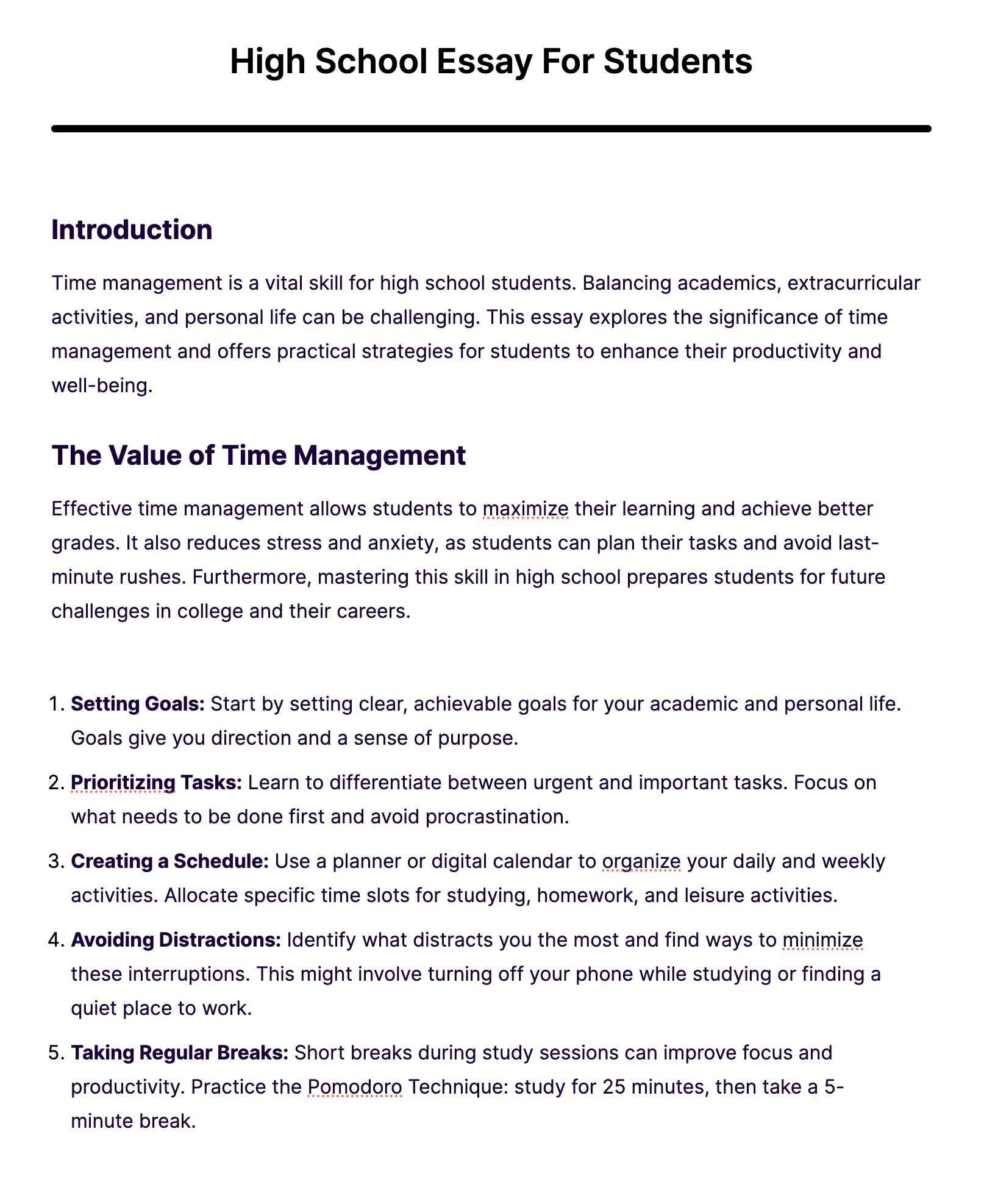
High School Essay Outline
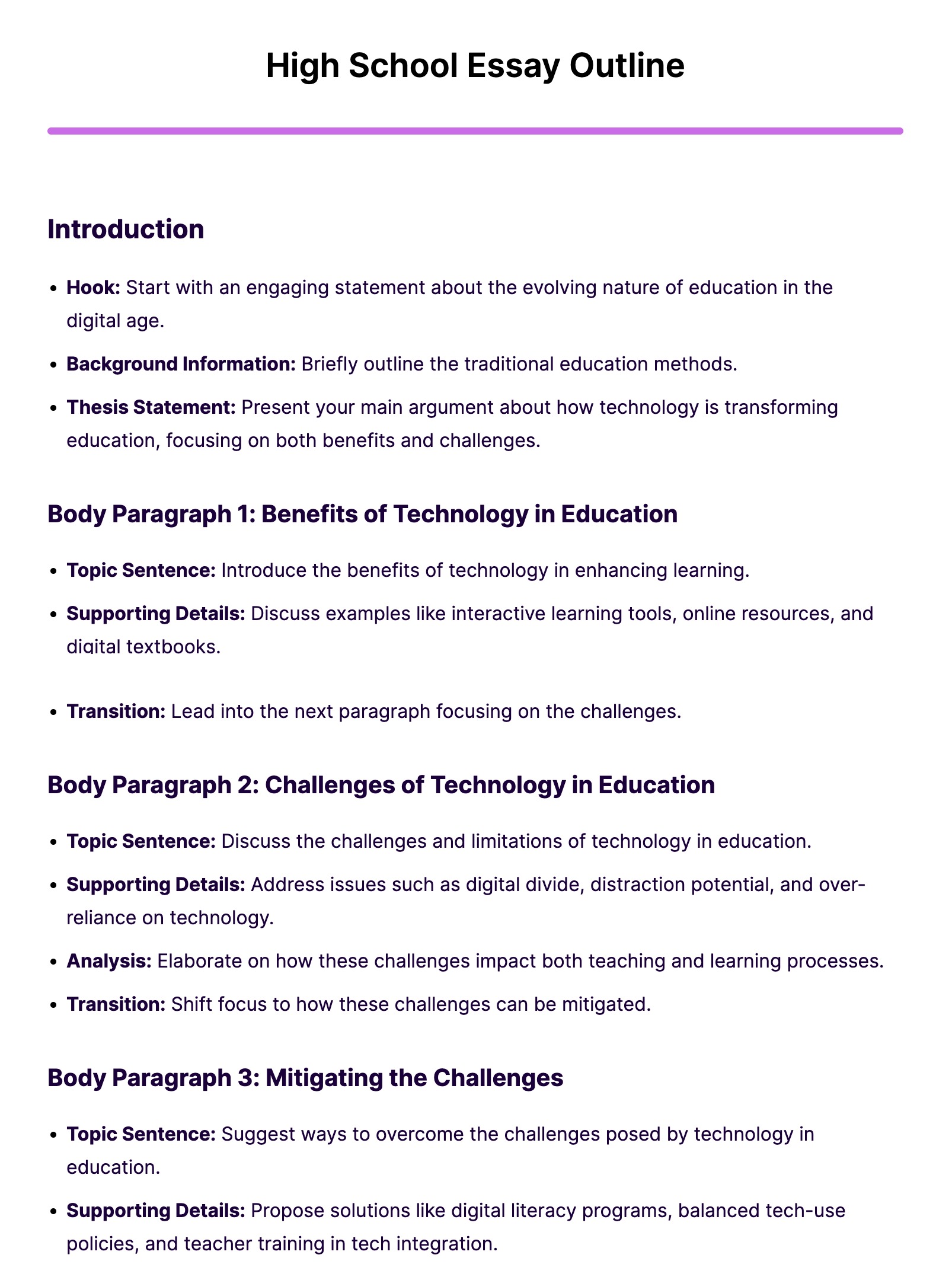
High School Essay Example
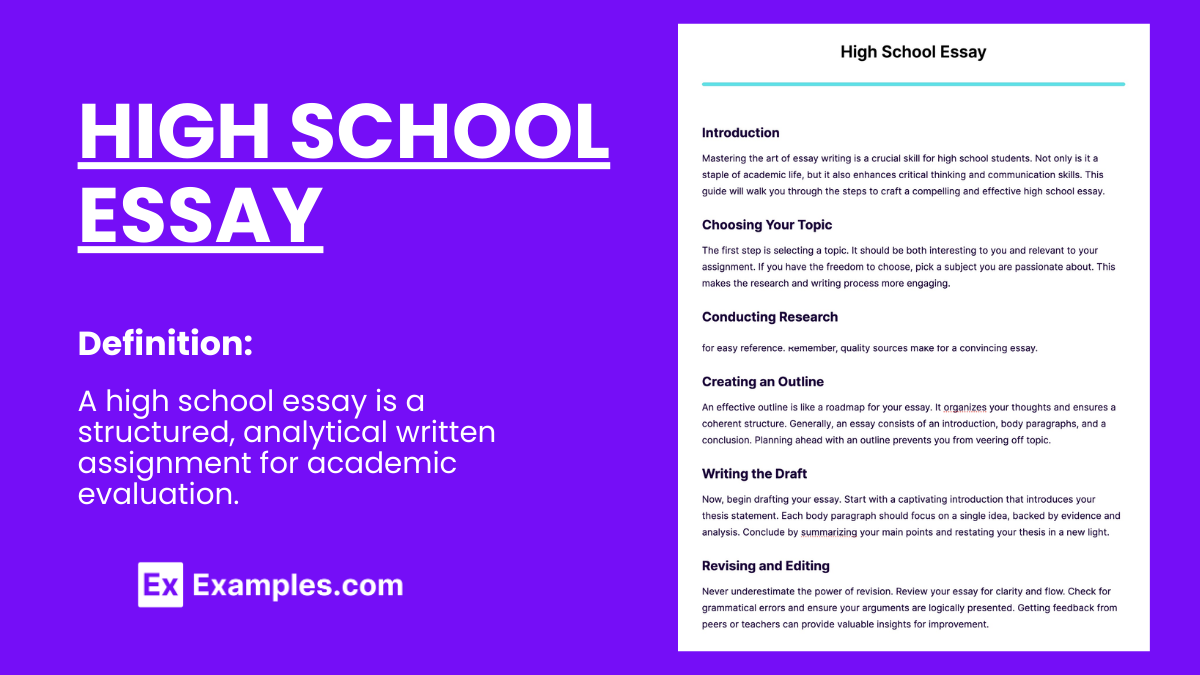
High School Self Introduction Essay Template
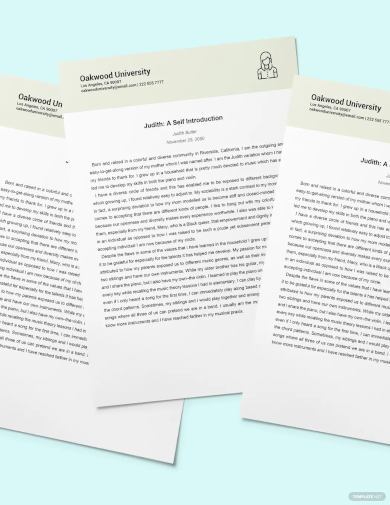
High School Student Essay
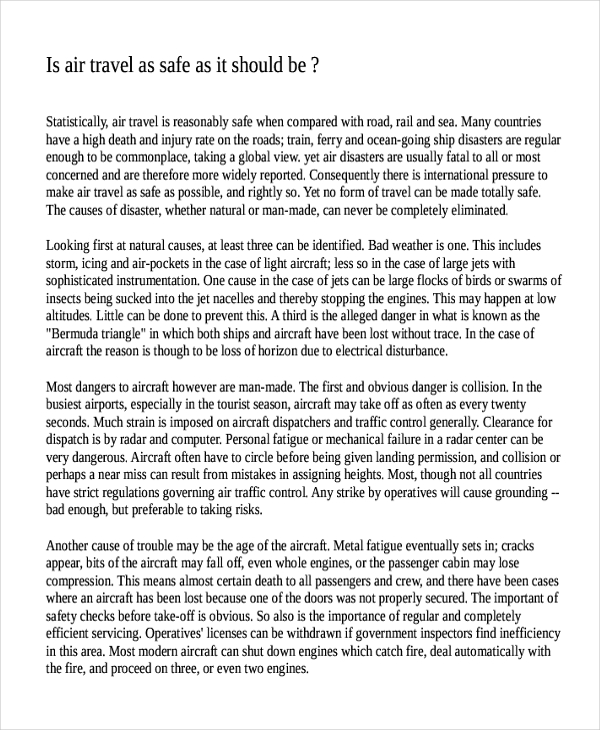
englishdaily626.com
Reflective High School
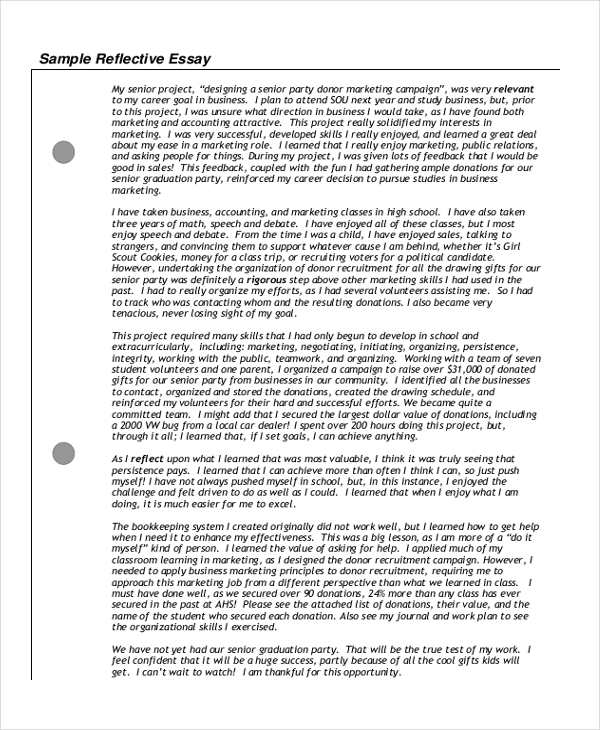
oregoncis.uoregon.edu
Argumentative Essays for High School
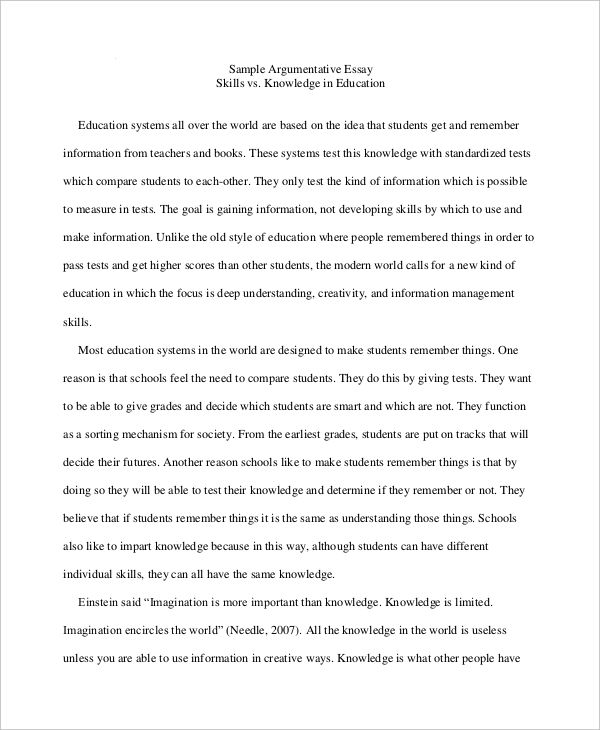
Informative Essays for High School
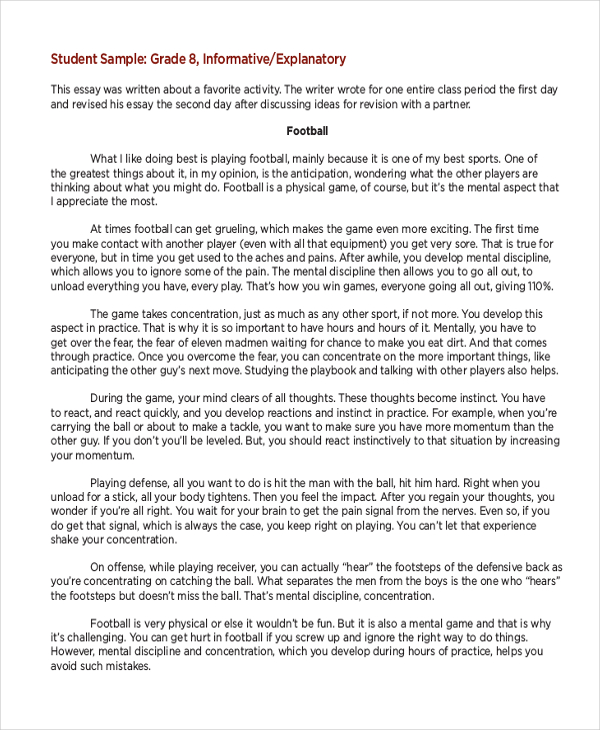
High School Persuasive
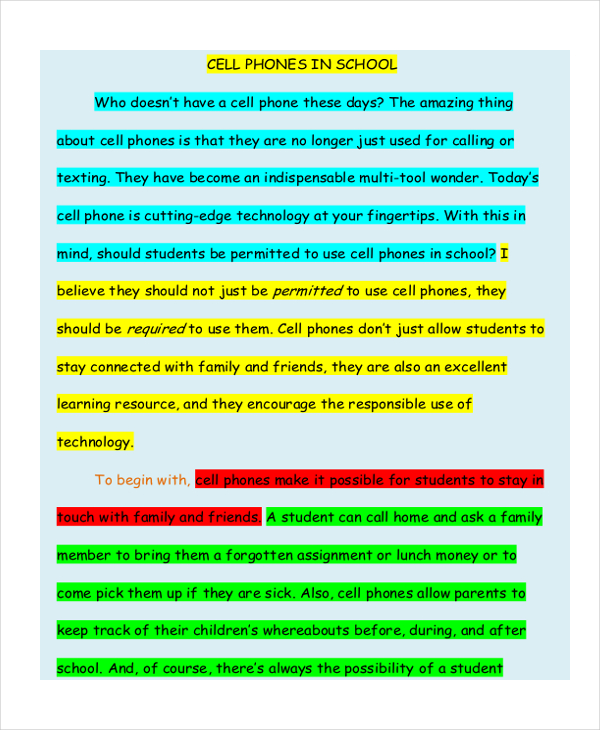
writecook.com
Narrative Essays
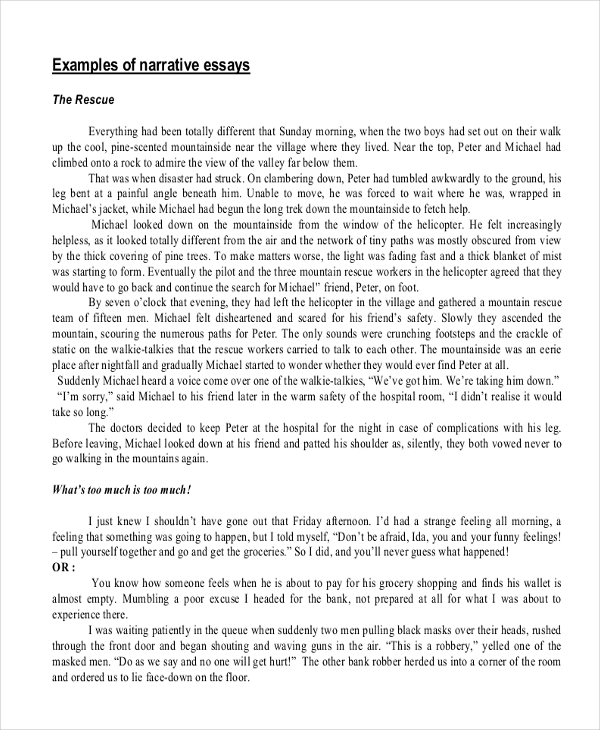
Scholarship Essays
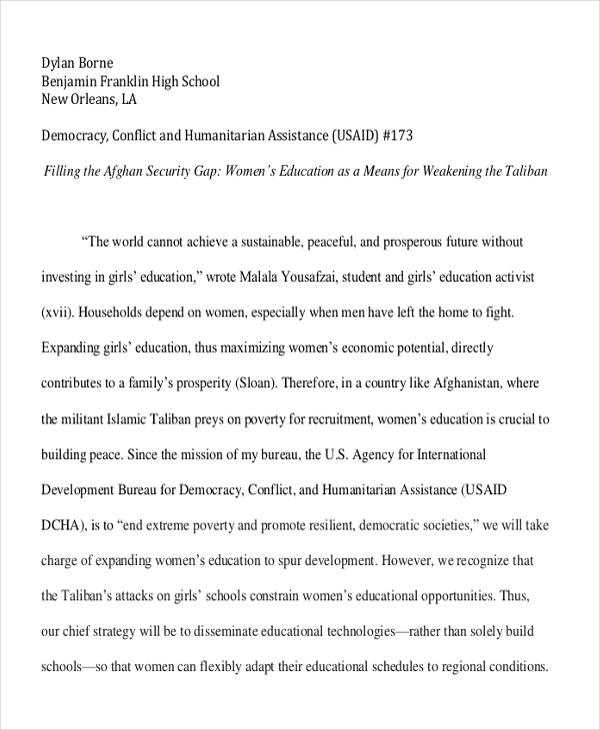
High School Application
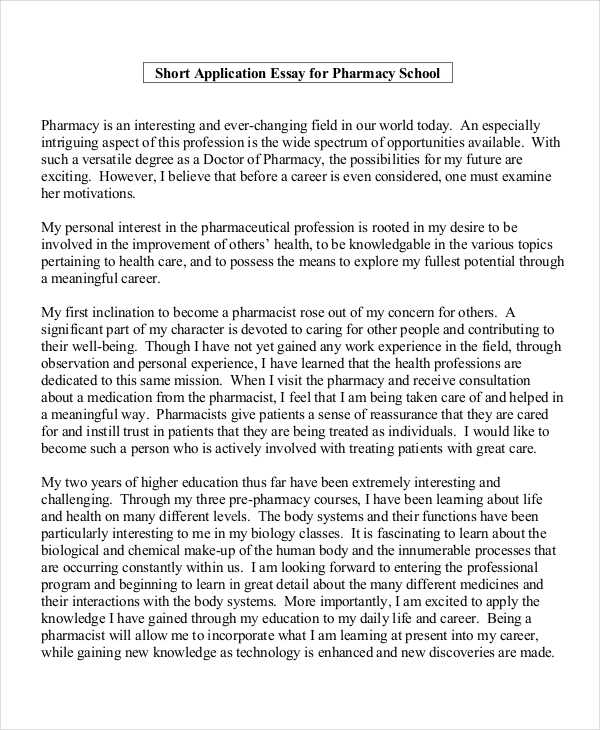
e-education.psu.edu
High School Graduation Essay
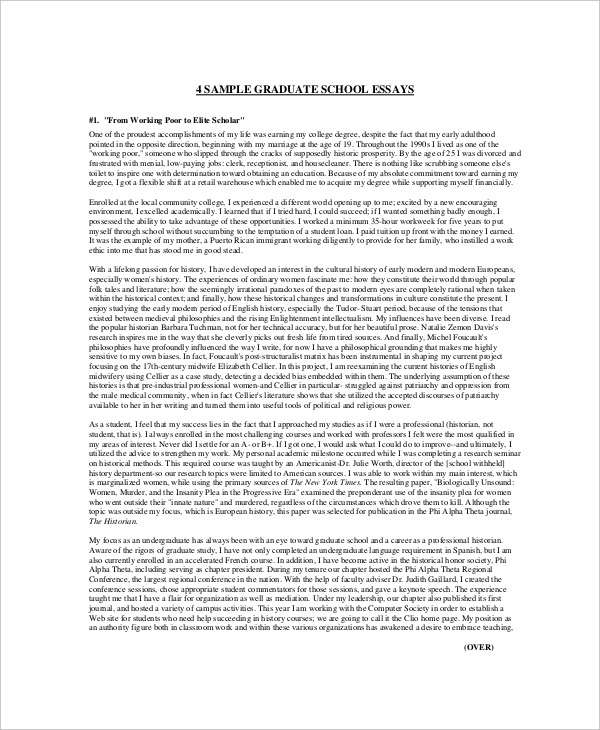
High School Leadership Essay
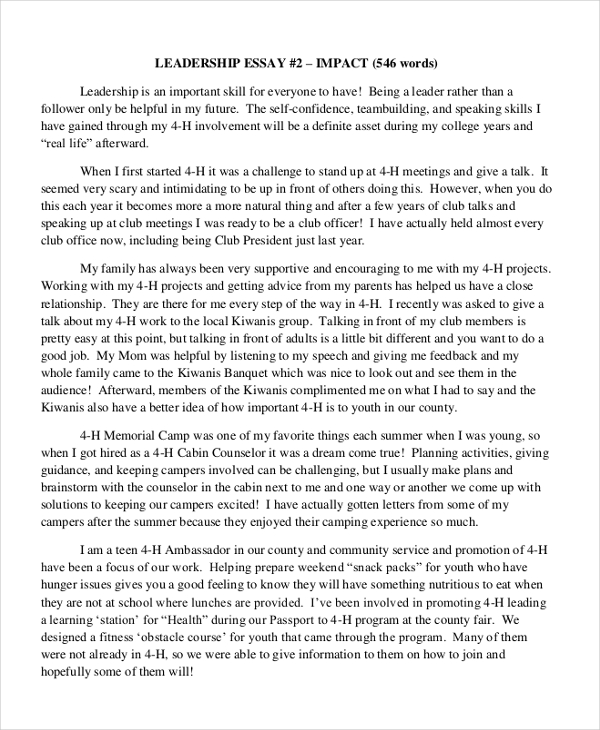
web.extension.illinois.edu
How to Write a High School Essay
Some teachers are really not that strict when it comes to writing essay because they too understand the struggles of writing stuff like these. However, you need to know the basics when it comes to writing a high school essay.
1. Understand the Essay Prompt
- Carefully read the essay prompt or question to understand what’s required. Identify the type of essay (narrative, persuasive, expository, etc.) and the main topic you need to address.
2. Choose a Topic
- If the topic isn’t provided, pick one that interests you and fits the essay’s requirements. Make sure it’s neither too broad nor too narrow.
3. Conduct Research (if necessary)
- For expository, argumentative, or research essays, gather information from credible sources to support your arguments. Take notes and organize your findings.
4. Create an Outline
- Outline your essay to organize your thoughts and structure your arguments effectively. Include an introduction, body paragraphs, and a conclusion.
5. Write the Introduction
- Start with a hook to grab the reader’s attention (a quote, a question, a shocking fact, etc.). Introduce your topic and end the introduction with a thesis statement that presents your main argument or purpose.
6. Develop Body Paragraphs
- Each body paragraph should focus on a single idea or argument that supports your thesis. Start with a topic sentence, provide evidence or examples, and explain how it relates to your thesis.
7. Write the Conclusion
- Summarize the main points of your essay and restate your thesis in a new way. Conclude with a strong statement that leaves a lasting impression on the reader.
Types of High School Essay
1. narrative essay.
Narrative essays tell a story from the writer’s perspective, often highlighting a personal experience or event. The focus is on storytelling, including characters, a setting, and a plot, to engage readers emotionally. This type allows students to explore creativity and expressiveness in their writing.
2. Descriptive Essay
Descriptive essays focus on detailing and describing a person, place, object, or event. The aim is to paint a vivid picture in the reader’s mind using sensory details. These essays test the writer’s ability to use language creatively to evoke emotions and bring a scene to life.
3. Expository Essay
Expository essays aim to explain or inform the reader about a topic in a clear, concise manner. This type of essay requires thorough research and focuses on factual information. It’s divided into several types, such as compare and contrast, cause and effect, and process essays, each serving a specific purpose.
4. Persuasive Essay
Persuasive essays aim to convince the reader of a particular viewpoint or argument. The writer must use logic, reasoning, and evidence to support their position while addressing counterarguments. This type tests the writer’s ability to persuade and argue effectively.
5. Analytical Essay
Analytical essays require the writer to break down and analyze an element, such as a piece of literature, a movie, or a historical event. The goal is to interpret and make sense of the subject, discussing its significance and how it achieves its purpose.
6. Reflective Essay
Reflective essays are personal pieces that ask the writer to reflect on their experiences, thoughts, or feelings regarding a specific topic or experience. It encourages introspection and personal growth by examining one’s responses and learning from them.
7. Argumentative Essay
Similar to persuasive essays, argumentative essays require the writer to take a stance on an issue and argue for their position with evidence. However, argumentative essays place a stronger emphasis on evidence and logic rather than emotional persuasion.
8. Research Paper
Though often longer than a typical essay, research papers in high school require students to conduct in-depth study on a specific topic, using various sources to gather information. The focus is on presenting findings and analysis in a structured format.
Tips for High School Essays
Writing a high school essay if you have the tips on how to do essay effectively . This will give you an edge from your classmates.
- Stay Organized: Keep your notes and sources well-organized to make the writing process smoother.
- Be Clear and Concise: Avoid overly complex sentences or vocabulary that might confuse the reader.
- Use Transitions: Ensure that your paragraphs and ideas flow logically by using transition words and phrases.
- Cite Sources: If you use direct quotes or specific ideas from your research, make sure to cite your sources properly to avoid plagiarism.
- Practice: Like any skill, essay writing improves with practice. Don’t hesitate to write drafts and experiment with different writing styles.
Importance of High School Essay
Aside from the fact that you will get reprimanded for not doing your task, there are more substantial reasons why a high school essay is important. First, you get trained at a very young age. Writing is not just for those who are studying nor for your teachers. As you graduate from high school and then enter college (can see college essays ), you will have more things to write like dissertations and theses.
At least, when you get to that stage, you already know how to write. Aside from that, writing high essays give a life lesson. That is, patience and resourcefulness. You need to find the right resources for your essay as well as patience when finding the right inspiration to write.
How long is a high school essay?
A high school essay typically ranges from 500 to 2000 words, depending on the assignment’s requirements and the subject matter.
How do you start a personal essay for high school?
Begin with an engaging hook (an anecdote, quote, or question) that introduces your theme or story, leading naturally to your thesis or main point.
What makes a good high school essay?
A good high school essay features a clear thesis, coherent structure, compelling evidence, and personal insights, all presented in a polished, grammatically correct format.
Text prompt
- Instructive
- Professional
Write a High School Essay on the importance of participating in sports.
Discuss the role of student government in high schools in a High School Essay.
- Success Stories
- AI Scholar Program
- Startup Internship Program
- Research Scholar Program
- GOALS Academic Support Program
- Test Prep Program
- Passion Project Program
- For Families
- For Schools
- For Employers
- Partnerships
- Content Guides
- News And Awards
- College Admissions
- Events and Webinars
- Grade Levels
- High School
Writing in High School vs. College
Madeleine Karydes
Lead admissions expert, table of contents, high school vs. college.
Stay up-to-date on the latest research and college admissions trends with our blog team.

Learning how to write well for college is fundamentally the most challenging dilemma students will face, in my experience. Academic writing in high school vs. college differ in key aspects. Let’s talk about how your writing must change when transitioning from high school to the university.
We get it. The night before a deadline, some high school students procrastinate instead of re-reading their copy of One Who Flew Over the Cuckoo’s Nest . It is a very common urge, to put off the high school essay–and it can be a very easy thing to pull off.
This is due in part to our high school education’s emphasis on summary as opposed to analysis. Most high schools want students to master the material instead of truly analyzing it. But when embarking on their college planning, students should also prepare for a major shift in writing standards.
Besides taking a writing workshop or working with a tutor recommended by a college planning adviser, a student should practice writing in a college format.
College writing will differ in these three key aspects :
1. Diversified Topics in your College Writing
Think about where a student spends the most time on writing. Is it science? Art? History? The most common answer is English. In college, what subject will demand the most writing?
The answer? Every subject. Even in a science or math class, students will be expected to read their textbook, read scholarly articles, and write extensive research papers. A student may choose to take subjects they’ve never been offered before, like philosophy, linguistics, archaeology, sociology, and more. In all college courses , a student will be expected to have strong writing skills and write a lot .
Tip: When a student is doing their college planning, they should research what subjects their ideal colleges offer and which ones appeal the most to them. If they’re feeling ambitious, they should read some of the writing published in those disciplines. This will give you a firsthand example of how writing in high school vs. college can differ.
2. Analysis Emphasized More Than High School Writing
Most high schools do not emphasize heavy research, analysis, or innovation in a given topic. University courses will usually demand a lot of depth. This can be very challenging for some students who were not effectively taught how to analyze or break down what’s in front of them.
The big difference is a shift from what to why. High school teachers will often ask what happened or what someone did . In college, since most professors are expected to make innovations in their own field, students will be asked why something happened and encouraged to look at the deeper significance of something.
Tip: Students should learn to ask themselves why more often, and early on. They should do their best to try and discover hidden motivations and theories for what surrounds them.
3. Thesis Based Writing in High School vs. College
In college, the thesis is the holy grail. Most students will know what a thesis is by the time they’re in college. If they don’t, not to worry–most universities will emphasize its importance very early on.
A thesis has many important elements (that should be discussed with a writing tutor or in a student’s first college writing course), but it is in essence an argument or conclusion made based off of research and evidence . In other words, it’s not simply what we know to be true already (“Under the presidency of Bill Clinton, NAFTA was passed”). It is not yet proven or could be challenged with another point of view, as in: “NAFTA made the Mexican economy overly dependent on the United States and had dangerous ramifications for their citizens.”
In fact, a student’s entire essay will surround their central argument. Anything that is irrelevant to their main claim should not be included in their paper.
Tip: Learning what a thesis looks like is essential to a student’s college planning. First, they should learn what it is by trying to identify it in articles or writing worksheets. Then, they should learn how to come up with one of their own. They can do this by reading about a subject they are passionate about and creating an argument based on the evidence they found.
Learning how to write well for college is fundamentally the most challenging dilemma students will face when transitioning from high school to the university. Whereas they used to be able to put off assignments until the night before and pull it off with grace, in college, they are expected to research outside of the text in front of them, analyze all of the material, come up with a strong thesis, and write clearly and concisely all in one go. It is not easy stuff.
If a student wants to come prepared, they should work on these skills now rather than later!
Share this article:
College apps can be overwhelming, but you don’t have to do it alone. empowerly college counseling is in it with you., related articles.

Juniors: How to Get on Track with College Prep
19 Computer Science Research Opportunities for High School Students

15 Pro Tips for Finding University Admissions Counselors in 2024
- Writing Home
- Writing Advice Home
The Transition from High School to University Writing
- Printable PDF Version
- Fair-Use Policy
To meet the expectations of university writing, you will need to unlearn rules you may have learned in high school. Those rules may have helped you to plan and write your essays by providing a ready-made structure you could fit your ideas into. But continuing to rely on these rules will limit your freedom to develop more sophisticated arguments and a more mature style.
Here are some important differences between high school rules and university expectations:
Essay Structure
Thesis Statement
Introduction and Conclusion
Presentation
Here are the overall differences between the two institutions in philosophy and approach:

Essay Writing: A complete guide for students and teachers
P LANNING, PARAGRAPHING AND POLISHING: FINE-TUNING THE PERFECT ESSAY
Essay writing is an essential skill for every student. Whether writing a particular academic essay (such as persuasive, narrative, descriptive, or expository) or a timed exam essay, the key to getting good at writing is to write. Creating opportunities for our students to engage in extended writing activities will go a long way to helping them improve their skills as scribes.
But, putting the hours in alone will not be enough to attain the highest levels in essay writing. Practice must be meaningful. Once students have a broad overview of how to structure the various types of essays, they are ready to narrow in on the minor details that will enable them to fine-tune their work as a lean vehicle of their thoughts and ideas.

In this article, we will drill down to some aspects that will assist students in taking their essay writing skills up a notch. Many ideas and activities can be integrated into broader lesson plans based on essay writing. Often, though, they will work effectively in isolation – just as athletes isolate physical movements to drill that are relevant to their sport. When these movements become second nature, they can be repeated naturally in the context of the game or in our case, the writing of the essay.
THE ULTIMATE NONFICTION WRITING TEACHING RESOURCE

- 270 pages of the most effective teaching strategies
- 50+ digital tools ready right out of the box
- 75 editable resources for student differentiation
- Loads of tricks and tips to add to your teaching tool bag
- All explanations are reinforced with concrete examples.
- Links to high-quality video tutorials
- Clear objectives easy to match to the demands of your curriculum
Planning an essay

The Boys Scouts’ motto is famously ‘Be Prepared’. It’s a solid motto that can be applied to most aspects of life; essay writing is no different. Given the purpose of an essay is generally to present a logical and reasoned argument, investing time in organising arguments, ideas, and structure would seem to be time well spent.
Given that essays can take a wide range of forms and that we all have our own individual approaches to writing, it stands to reason that there will be no single best approach to the planning stage of essay writing. That said, there are several helpful hints and techniques we can share with our students to help them wrestle their ideas into a writable form. Let’s take a look at a few of the best of these:
BREAK THE QUESTION DOWN: UNDERSTAND YOUR ESSAY TOPIC.
Whether students are tackling an assignment that you have set for them in class or responding to an essay prompt in an exam situation, they should get into the habit of analyzing the nature of the task. To do this, they should unravel the question’s meaning or prompt. Students can practice this in class by responding to various essay titles, questions, and prompts, thereby gaining valuable experience breaking these down.
Have students work in groups to underline and dissect the keywords and phrases and discuss what exactly is being asked of them in the task. Are they being asked to discuss, describe, persuade, or explain? Understanding the exact nature of the task is crucial before going any further in the planning process, never mind the writing process .
BRAINSTORM AND MIND MAP WHAT YOU KNOW:
Once students have understood what the essay task asks them, they should consider what they know about the topic and, often, how they feel about it. When teaching essay writing, we so often emphasize that it is about expressing our opinions on things, but for our younger students what they think about something isn’t always obvious, even to themselves.
Brainstorming and mind-mapping what they know about a topic offers them an opportunity to uncover not just what they already know about a topic, but also gives them a chance to reveal to themselves what they think about the topic. This will help guide them in structuring their research and, later, the essay they will write . When writing an essay in an exam context, this may be the only ‘research’ the student can undertake before the writing, so practicing this will be even more important.
RESEARCH YOUR ESSAY
The previous step above should reveal to students the general direction their research will take. With the ubiquitousness of the internet, gone are the days of students relying on a single well-thumbed encyclopaedia from the school library as their sole authoritative source in their essay. If anything, the real problem for our students today is narrowing down their sources to a manageable number. Students should use the information from the previous step to help here. At this stage, it is important that they:
● Ensure the research material is directly relevant to the essay task
● Record in detail the sources of the information that they will use in their essay
● Engage with the material personally by asking questions and challenging their own biases
● Identify the key points that will be made in their essay
● Group ideas, counterarguments, and opinions together
● Identify the overarching argument they will make in their own essay.
Once these stages have been completed the student is ready to organise their points into a logical order.
WRITING YOUR ESSAY
There are a number of ways for students to organize their points in preparation for writing. They can use graphic organizers , post-it notes, or any number of available writing apps. The important thing for them to consider here is that their points should follow a logical progression. This progression of their argument will be expressed in the form of body paragraphs that will inform the structure of their finished essay.
The number of paragraphs contained in an essay will depend on a number of factors such as word limits, time limits, the complexity of the question etc. Regardless of the essay’s length, students should ensure their essay follows the Rule of Three in that every essay they write contains an introduction, body paragraphs, and a conclusion.
Generally speaking, essay paragraphs will focus on one main idea that is usually expressed in a topic sentence that is followed by a series of supporting sentences that bolster that main idea. The first and final sentences are of the most significance here with the first sentence of a paragraph making the point to the reader and the final sentence of the paragraph making the overall relevance to the essay’s argument crystal clear.
Though students will most likely be familiar with the broad generic structure of essays, it is worth investing time to ensure they have a clear conception of how each part of the essay works, that is, of the exact nature of the task it performs. Let’s review:
Common Essay Structure
Introduction: Provides the reader with context for the essay. It states the broad argument that the essay will make and informs the reader of the writer’s general perspective and approach to the question.
Body Paragraphs: These are the ‘meat’ of the essay and lay out the argument stated in the introduction point by point with supporting evidence.
Conclusion: Usually, the conclusion will restate the central argument while summarising the essay’s main supporting reasons before linking everything back to the original question.
ESSAY WRITING PARAGRAPH WRITING TIPS

● Each paragraph should focus on a single main idea
● Paragraphs should follow a logical sequence; students should group similar ideas together to avoid incoherence
● Paragraphs should be denoted consistently; students should choose either to indent or skip a line
● Transition words and phrases such as alternatively , consequently , in contrast should be used to give flow and provide a bridge between paragraphs.
HOW TO EDIT AN ESSAY

Students shouldn’t expect their essays to emerge from the writing process perfectly formed. Except in exam situations and the like, thorough editing is an essential aspect in the writing process.
Often, students struggle with this aspect of the process the most. After spending hours of effort on planning, research, and writing the first draft, students can be reluctant to go back over the same terrain they have so recently travelled. It is important at this point to give them some helpful guidelines to help them to know what to look out for. The following tips will provide just such help:
One Piece at a Time: There is a lot to look out for in the editing process and often students overlook aspects as they try to juggle too many balls during the process. One effective strategy to combat this is for students to perform a number of rounds of editing with each focusing on a different aspect. For example, the first round could focus on content, the second round on looking out for word repetition (use a thesaurus to help here), with the third attending to spelling and grammar.
Sum It Up: When reviewing the paragraphs they have written, a good starting point is for students to read each paragraph and attempt to sum up its main point in a single line. If this is not possible, their readers will most likely have difficulty following their train of thought too and the paragraph needs to be overhauled.
Let It Breathe: When possible, encourage students to allow some time for their essay to ‘breathe’ before returning to it for editing purposes. This may require some skilful time management on the part of the student, for example, a student rush-writing the night before the deadline does not lend itself to effective editing. Fresh eyes are one of the sharpest tools in the writer’s toolbox.
Read It Aloud: This time-tested editing method is a great way for students to identify mistakes and typos in their work. We tend to read things more slowly when reading aloud giving us the time to spot errors. Also, when we read silently our minds can often fill in the gaps or gloss over the mistakes that will become apparent when we read out loud.
Phone a Friend: Peer editing is another great way to identify errors that our brains may miss when reading our own work. Encourage students to partner up for a little ‘you scratch my back, I scratch yours’.
Use Tech Tools: We need to ensure our students have the mental tools to edit their own work and for this they will need a good grasp of English grammar and punctuation. However, there are also a wealth of tech tools such as spellcheck and grammar checks that can offer a great once-over option to catch anything students may have missed in earlier editing rounds.

Putting the Jewels on Display: While some struggle to edit, others struggle to let go. There comes a point when it is time for students to release their work to the reader. They must learn to relinquish control after the creation is complete. This will be much easier to achieve if the student feels that they have done everything in their control to ensure their essay is representative of the best of their abilities and if they have followed the advice here, they should be confident they have done so.
WRITING CHECKLISTS FOR ALL TEXT TYPES

⭐⭐⭐⭐⭐ (92 Reviews)
ESSAY WRITING video tutorials

+1 (603) 932 7897

- 5 Common Types of High School Essays (With Examples)
- Last modified 2024-04-01
- Published on 2021-08-28

When it comes to high school essays, descriptive and narrative essays are very similar in the sense that they encourage writers to be creative in expressing their ideas. Expository and argumentative essays focus on providing clear information and making compelling points. Analytical essays require writers to present their arguments and are intended to enhance readers’ understanding of a topic, while persuasive writers try to persuade readers to accept a point of view.
In this article, we will go into detail about each one to help you better define the type and the writing method when you start writing.
1. Descriptive high school essays
A descriptive essay asks writers to describe something vividly —object, person, place, experience, emotion, situation, etc., but more commonly, you will be asked to describe something abstract —emotions, experiences, or something outside of your typical experience.
A descriptive essay allows writers to be creative and have the freedom to express, especially when the topic is personal about them and what they care about, such as their favorite food or culture. Even though this sounds easy, this type of essay tests the writer’s ability to make appropriate word choices and have strong creativity to help readers visualize the overall picture of what they are writing about. A descriptive essay normally starts with introducing the subject or object of description, continuing with giving an overall picture, and then going into details. Additionally, understanding different points of view, as detailed in the Guide to Point of View in Writing , can greatly enhance the descriptive elements of the essay, providing varied perspectives and enriching the reader’s experience
Below is an example of a descriptive essay from Yourdictionary :
I watched a thunderstorm, far out over the sea. It began quietly, and with nothing visible except tall dark clouds and a rolling tide. There was just a soft murmur of thunder as I watched the horizon from my balcony. Over the next few minutes, the clouds closed and reflected lightning set the rippling ocean aglow. The thunderheads had covered up the sun, shadowing the vista. It was peaceful for a long time.
I was looking up when the first clear thunderbolt struck. It blazed against the sky and sea; I could see its shape in perfect reverse colors when I blinked. More followed. The thunder rumbled and stuttered as if it could hardly keep up. There were openings in the cloud now, as if the sky were torn, and spots of brilliant blue shone above the shadowed sea.
I looked down then, watching the waves. Every bolt was answered by a moment of spreading light on the surface. The waves were getting rough, rising high and crashing hard enough that I could hear them.
Then came the rain. It came all at once and in sheets, soaking the sand, filling the sea. It was so dense I could only see the lightning as flashes of light. It came down so hard the thunder was drowned. Everything was rhythmic light and shadow, noise and silence, blending into a single experience of all five senses.
In an instant it stopped. The storm broke. The clouds came apart like curtains. The rain still fell, but softly now. It was as if there had never been a storm at all, except for a single signature. A rainbow, almost violently bright, spread above and across the water. I could see the horizon again.
2. Narrative Essay
A narrative high school essay is similar to a descriptive essay but focuses more on the story description rather than the object description. The story can be about a personal experience that the writer has had, an event, a story, or an incident. Writers can even narrate a fictional experience that they haven’t had. Narrative essays are typically written in the first person. For example, the personal statement high school students must write for college applications.
The purpose of a narrative essay is not only to tell a story, but also to highlight the importance of the experience. Therefore, to write a perfect narrative essay, writers must include the elements of settings, context, plot, ending, and climax.
We have an example from a student’s work, which was published on the blog: People’s Republic of Creativity
Glup, glup.
I sat watching the plunger slowly make its way down the tube and into Miriam’s body. Inside the tube was a clear unknown liquid that would soon be injected into my own body. This was the third time this week, the twelfth time this month, and who knows how many times since we have been trapped in this hell on earth. Each day, we have only been given the bare minimum of food, water, and sleep. I don’t know how much longer we can survive before deemed useless by him.
Miriam fell out of her chair and onto the cold concrete floor, screaming in pain. She scrambles for something she can grasp onto to prop her malnourished body up. Then the piercing sound just suddenly stopped. Her thin arms that look only of bones and skin drop to the ground and she lay still on the floor, as if she were…dead. Please don’t tell me she’s dead! No, she couldn’t be; we promised each other to live until the day of liberation.
She needs to live.
It was my turn. He walked over with a syringe full of what had just been injected into Miriam. I try to focus on the red, black, and white badge on his left arm instead of letting the fear crawl in and take over my brain. But the unsettling tension stirs my thoughts around and around.
“Twin A1387, let’s hope what happened to your sister doesn’t happen to you.” He smirked. The needle pierced through my skin and my body was suddenly aflame. The raging blaze spread through every one of my veins, until I was shrouded in darkness.
When I opened my eyes again, I found myself in an empty confinement. The space next to me, the space for Miriam, was empty too. Where was everyone? Most importantly, where was Miriam?
I got up and set my bare foot onto the dirty, wooden floor. Suddenly, my head started spinning and along with it, the world spun too. I fell to the ground, and when I could finally lift my head, what I saw above me terrified me. It was him, death in human form, and beside him were four of his helpers. They grabbed my arms and forced me to stand up.
“Good morning A1387. I am afraid your dear twin sister couldn’t handle the injections from yesterday. Let’s hope your fragile little limbs can endure those chemicals. I wonder how many more injections it will take for you to meet your pathetic sister,” he said, patting my head. His tone was playful, but deadly.
I froze. What? Miriam…dead? That one word, “twins”, has taken away everything of what feels like my past life, and now my last hope? I felt a surge of anger, hatred, sadness, fear, devastation swirling inside me like boiling lava in a volcano, ready to erupt. I wanted to scream, to shout, to kill him, but I couldn’t. My soft limbs felt as if they would collapse merely by trying to stand up. They would be harmless and defenceless against the Angel of Death. When he saw the hatred on my face, he started laughing hysterically and simply said, “What a shame; she was only 13. I cannot wait to see how long it will take for you to fall apart!”
3. Expository Essay
According to Purdue University , the expository essay is a genre of essay that requires the student to investigate an idea, evaluate evidence, expound on the idea, and set forth an argument concerning that idea in a clear and concise manner. To accomplish this, writers use the method of comparison and contrast, definition, example, cause and effect, etc.
Writers are not required to argue or make a personal opinion but to present balanced and well-organized facts and figures.
In an expository essay–as the name suggests–you need to expose the particular subject in question by providing enough information. It is an informative piece of writing that provides a balanced analysis of the topic. It does not contain any personal opinion; instead, it is based on real facts and figures. Therefore, this kind of high school essay is commonly assigned in high school or college in order to test students’ familiarity with a topic and ability to convey information.
This is an example from College Board’s SAT Writing Prompt.
In response to our world’s growing reliance on artificial light, writer Paul Bogard argues that natural darkness should be preserved in his article “Let There be dark”. He effectively builds his argument by using a personal anecdote, allusions to art and history, and rhetorical questions.
Bogard starts his article off by recounting a personal story – a summer spent on a Minnesota lake where there was “woods so dark that [his] hands disappeared before [his] eyes.” In telling this brief anecdote, Bogard challenges the audience to remember a time where they could fully amass themselves in natural darkness void of artificial light. By drawing in his readers with a personal encounter about night darkness, the author means to establish the potential for beauty, glamour, and awe-inspiring mystery that genuine darkness can possess. He builds his argument for the preservation of natural darkness by reminiscing for his readers a first-hand encounter that proves the “irreplaceable value of darkness.” This anecdote provides a baseline of sorts for readers to find credence with the author’s claims.
Bogard’s argument is also furthered by his use of allusion to art – Van Gogh’s “Starry Night” – and modern history – Paris’ reputation as “The City of Light”. By first referencing “Starry Night”, a painting generally considered to be undoubtedly beautiful, Bogard establishes that the natural magnificence of stars in a dark sky is definite. A world absent of excess artificial light could potentially hold the key to a grand, glorious night sky like Van Gogh’s according to the writer. This urges the readers to weigh the disadvantages of our world consumed by unnatural, vapid lighting. Furthermore, Bogard’s alludes to Paris as “the famed ‘city of light’”. He then goes on to state how Paris has taken steps to exercise more sustainable lighting practices. By doing this, Bogard creates a dichotomy between Paris’ traditionally alluded-to name and the reality of what Paris is becoming – no longer “the city of light”, but moreso “the city of light…before 2 AM”. This furthers his line of argumentation because it shows how steps can be and are being taken to preserve natural darkness. It shows that even a city that is literally famous for being constantly lit can practically address light pollution in a manner that preserves the beauty of both the city itself and the universe as a whole.
Finally, Bogard makes subtle yet efficient use of rhetorical questioning to persuade his audience that natural darkness preservation is essential. He asks the readers to consider “what the vision of the night sky might inspire in each of us, in our children or grandchildren?” in a way that brutally plays to each of our emotions. By asking this question, Bogard draws out heartfelt ponderance from his readers about the affecting power of an untainted night sky. This rhetorical question tugs at the readers’ heartstrings; while the reader may have seen an unobscured night skyline before, the possibility that their child or grandchild will never get the chance sways them to see as Bogard sees. This strategy is definitively an appeal to pathos, forcing the audience to directly face an emotionally-charged inquiry that will surely spur some kind of response. By doing this, Bogard develops his argument, adding gutthral power to the idea that the issue of maintaining natural darkness is relevant and multifaceted.
Writing as a reaction to his disappointment that artificial light has largely permeated the presence of natural darkness, Paul Bogard argues that we must preserve true, unaffected darkness. He builds this claim by making use of a personal anecdote, allusions, and rhetorical questioning.
4. Argumentative Essay
The argumentative high school essay is similar to the expository essay, because it requires writers to present their evidence-based arguments. Writers have to present a thesis statement, gather and evaluate evidence, and establish a position on the topic. Many people think argumentative and expository essays are the same. They belong to a similar genre, but an argumentative essay requires more research than an expository essay. An expository essay is normally used in the SAT test, because test takers are required to investigate and present points from the prompts given. An argumentative essay is generally used in a final project or a capstone, which requires length and detailed research. The essay is divided into 3 parts: introduction, body, and conclusion. The introduction has a topic and thesis statement, the body has evidence and arguments, and the conclusion summarizes the arguments and potential directions for future research.
Below is an example from a GRE writing answer from ETS :
Prompt : The best ideas arise from a passionate interest in commonplace things
Discuss the extent to which you agree or disagree with the statement above and explain your reasoning for the position you take. In developing and supporting your position, you should consider ways in which the statement might or might not hold true and explain how those considerations shape your position.
Passion is clearly necessary for a truly great idea to take hold among a people—passion either
on the part of the original thinker, the audience, or ideally both. The claim that the most lucrative
subject matter for inspiring great ideas is “commonplace things” may seem initially to be counterintuitive. After all, aren’t great ideas usually marked by their extraordinary character? While this is true, their extraordinary character is as often as not directly derived from their insight into things that had theretofore gone unquestioned. While great ideas certainly can arise through seemingly pure innovation… say, for example, Big Bang cosmology, which developed nearly all of its own scientific and philosophical precepts through its own process of formation, it is nevertheless equally true that such groundbreaking thought was, and is, still largely
a reevaluation of previous assumptions to a radical degree… after all, the question of the ultimate nature of the universe, and man’s place in it, has been central to human thought since the dawn of time. Commonplace things are, additionally, necessary as material for the generation of “the best ideas” since certainly the success among an audience must be considered in evaluating the significance and quality of an idea.
The advent of Big Bang cosmology, which occurred in rudimentary form almost immediately upon Edwin Hubble’s first observations at the Hooker telescope in California during the early 20th century, was the most significant advance in mankind’s understanding of the universe in over 400 years. The seemingly simple fact that everything in the universe, on a very large scale, is moving away from everything else in fact betrays nearly all of our scientific knowledge of the origins and mechanics of the universe. This slight, one might even say commonplace, distortion of tint on a handful of photographic plates carried with it the greatest challenge to Man’s general, often religiously reinforced, conception of the nature of the world to an extent not seen since the days of Galileo. Not even Charles Darwin’s theory, though it created more of a stir than Big Bang cosmology, had such shattering implications for our conceptions of the nature of our reality. Yet it is not significant because it introduced the question of the nature of what lies beyond Man’s grasp. A tremendous number of megalithic ruins, including the Pyramids both of Mexico and Egypt, Stonehenge, and others, indicate that this question has been foremost on humankind’s collective mind since time immemorial. Big Bang cosmology is so incredibly significant in this line of reasoning exactly because of the degree to which it changed the direction of this generally held, constantly pondered, and very ancient train of thought.
Additionally, there is a diachronic significance to the advent of Big Bang cosmology, which is that, disregarding limitations such as the quality of optical devices available and the state of theoretical math, it could have happened at any point in time. That is to say, all evidence points to roughly the same raw intellectual capacity for homo sapiens throughout our history, our progress has merely depended upon the degree of it that a person happens to inherit, a pace that has been increasing rapidly since the industrial revolution. Yet this discovery had to happen at a certain point in time or another—it cannot have been happening constantly or have never happened yet still be present—and this point in time does have its own significance. That significance is precisely the fact that the aforementioned advent must have occurred at precisely the point in time at which it truly could have occurred—that is to say, it marks the point in our history when we had progressed sufficiently to begin examining, with remarkable substantiated acuity, the workings of the universe across distances that would take millions of human lifetimes to reach or to traverse. The point for the success of this advent must necessarily have been, additionally, the point at which the audience concerned was capable and prepared to accept such a radical line of reasoning.
Both factors, a radical, passionate interpretation of the commonplace and the preparedness to accept such an interpretation, are necessary for the formulation of a truly great idea. If the passion is absent from an inquiry by the thinker or by the bulk of an audience, the idea will die out if it comes to fruition at all. If the material is not sufficiently commonplace to be considered by an informed audience of sufficient size, the same two hazards exist. Given these two factors, the idea must still be found palatable and interesting by the audience if it is to hope to gain a foothold and eventually establish itself in a significant fashion.
5. Analytical Essay
An analytical essay is a writing genre that provides an in-depth analysis of a topic, ranging from art, music, and literary text to politics, science, and philosophy, etc. Analytical essays can boost a writer’s writing skills and overall comprehension of a topic while helping readers become more educated about the subjects of importance. This type of essay does not aim to persuade readers to a certain point of view but rather to provide a well-rounded and comprehensive analysis for the readers. The analytical essay is normally used in the GRE writing section.
A good analytical essay includes a thesis statement stating your main argument, followed by an analysis of your thesis and supporting evidence. Here are the 7 Steps to Write a Literary Analysis Essay .
We will take an example from a student’s work about CRISPR, a genetic engineering method. The full essay can be accessed here , but below is the preview of the essay:
No matter how much money people are willing to pay for health care, they may still suffer terribly from incurable diseases such as AIDS and cancer because of the underdevelopment of medical technology. However, today, the advancement in human knowledge has led to the introduction of human gene-editing, turning impossibility to possibility. In particular, the recent technology for genome editing called CRISPR has been having a groundbreaking impact on research in genetic science. This is due to its remarkable potential to simply cure genetic diseases in an embryo before they have a serious effect on further developmental progression. Although currently, there have been numerous debates regarding its extension in research for widespread uses, CRISPR is a completely promising technology because of the benefits it brings to people.
CRISPR, or Clustered regularly interspaced short palindromic repeats, is the newest innovation in genetic engineering. The way CRISPR works is similar to “the scissor-like action of Cas 9 to target… any specific DNA sequence” (Baylis and Rossant). By making cuts in specific locations in DNA, CRISPR can cure diseases and make alterations in an embryo’s DNA, which prevent diseases from being passed down to following generations (Baylis and Rossant). Throughout the history, governments and researchers came up with different approaches politically and scientifically in attempt to control population. They hoped to encourage the “richest, wisest and healthiest to breed like rabbits” and the “sick, stupid, and poor to take one for the empire and remain childless” (Comfort 28). The second attempt happened during the 20th century, when the U.S government passed the law preventing marriage and immigration that would threaten a perceived core American “stock.” Another more extreme example was when Nazi sterilization law further advanced this population control approach. Later in the century, a biotechnological approach was established as a safer and more humane way to manage population health (qtd in Comfort 28). “Gene surgery,” which is similar to CRISPR technology, was established and followed by contentious debates regarding ethical issues between disease treatment and human trait enhancements. Currently, there has been a halt in the use of CRISPR because of the increase in concern from the public about the pros and cons of this technology.
Further reading:
- Where to Submit Your Writing Works: 5 Main Platforms
- 6 Differences between High School and College Writing
- 20 Tips to Improve Your Writing
- Guide to Point of View in Writing
- 10 Mistakes High School Students Make in Creative Writing
- How to Overcome Writer’s Block in High School Writing Competitions
Aralia Writing Courses

This class is offered in the summer every year. Students from 13 to 18 years old wanting to learn how to shape their written English into effective and publishable creative pieces will find this particular Writing Competition course very exciting. The class will be shown a range of tools to learn the nuances of controlled, purposeful writing, including: figurative language, effective structuring and specific forms that they will apply to their own pieces.

This course helps students develop and improve their writing skills to prepare students for higher education courses. The methodology emphasizes the ability to read critically, think critically, and write critically. Students will learn informative, narrative, descriptive, creative, and persuasive essay writing skills. Students will learn how to brainstorm, structure and outline, form an argument, defend it, incorporate academic sources, and develop a clear, articulate writing style. The focus will be on the writing process, intended audience, consistent tenses, point of view, correct grammar uses, building vocabulary, appropriate style, and proper research and citation protocols.
- Academic Tips
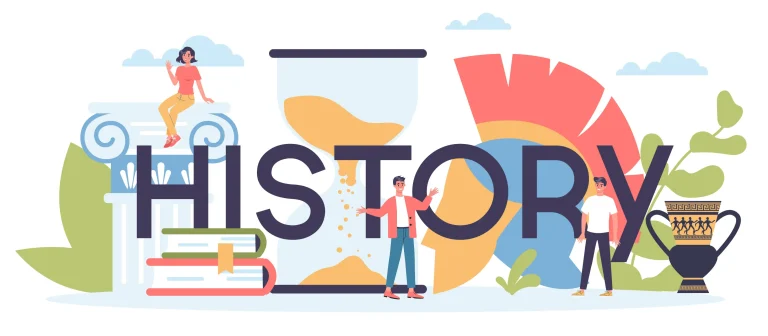
Aralia Education is an innovative online education platform for ambitious middle and high school students worldwide. Aralia’s instructors propel students forward by helping them build a strong foundation in traditional academic courses. They also actively engage and guide students in exploring personal interests beyond their school curriculum. With this holistic approach, Aralia ensures its students are well-prepared for college and equipped for success in their future careers.
- College Accelerator Program
- Comprehensive Introduction to High School
- Academic Empowerment Program
- Test Preparation Bootcamp
- Private Lessons
- Student Awards
- Competitions
Give us a call: +1 (603) 932 7897
Email us: [email protected]
Add us on WhatsApp:

Thank you for visiting nature.com. You are using a browser version with limited support for CSS. To obtain the best experience, we recommend you use a more up to date browser (or turn off compatibility mode in Internet Explorer). In the meantime, to ensure continued support, we are displaying the site without styles and JavaScript.
- View all journals
- My Account Login
- Explore content
- About the journal
- Publish with us
- Sign up for alerts
- Open access
- Published: 02 December 2020
Enhancing senior high school student engagement and academic performance using an inclusive and scalable inquiry-based program
- Locke Davenport Huyer ORCID: orcid.org/0000-0003-1526-7122 1 , 2 na1 ,
- Neal I. Callaghan ORCID: orcid.org/0000-0001-8214-3395 1 , 3 na1 ,
- Sara Dicks 4 ,
- Edward Scherer 4 ,
- Andrey I. Shukalyuk 1 ,
- Margaret Jou 4 &
- Dawn M. Kilkenny ORCID: orcid.org/0000-0002-3899-9767 1 , 5
npj Science of Learning volume 5 , Article number: 17 ( 2020 ) Cite this article
43k Accesses
5 Citations
13 Altmetric
Metrics details
The multi-disciplinary nature of science, technology, engineering, and math (STEM) careers often renders difficulty for high school students navigating from classroom knowledge to post-secondary pursuits. Discrepancies between the knowledge-based high school learning approach and the experiential approach of future studies leaves some students disillusioned by STEM. We present Discovery , a term-long inquiry-focused learning model delivered by STEM graduate students in collaboration with high school teachers, in the context of biomedical engineering. Entire classes of high school STEM students representing diverse cultural and socioeconomic backgrounds engaged in iterative, problem-based learning designed to emphasize critical thinking concomitantly within the secondary school and university environments. Assessment of grades and survey data suggested positive impact of this learning model on students’ STEM interests and engagement, notably in under-performing cohorts, as well as repeating cohorts that engage in the program on more than one occasion. Discovery presents a scalable platform that stimulates persistence in STEM learning, providing valuable learning opportunities and capturing cohorts of students that might otherwise be under-engaged in STEM.
Similar content being viewed by others
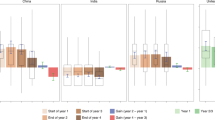
Skill levels and gains in university STEM education in China, India, Russia and the United States
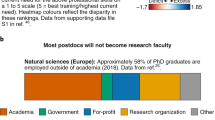
Academic ecosystems must evolve to support a sustainable postdoc workforce
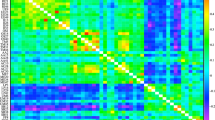
Dataset and validation of the approaches to study skills inventory for students
Introduction.
High school students with diverse STEM interests often struggle to understand the STEM experience outside the classroom 1 . The multi-disciplinary nature of many career fields can foster a challenge for students in their decision to enroll in appropriate high school courses while maintaining persistence in study, particularly when these courses are not mandatory 2 . Furthermore, this challenge is amplified by the known discrepancy between the knowledge-based learning approach common in high schools and the experiential, mastery-based approaches afforded by the subsequent undergraduate model 3 . In the latter, focused classes, interdisciplinary concepts, and laboratory experiences allow for the application of accumulated knowledge, practice in problem solving, and development of both general and technical skills 4 . Such immersive cooperative learning environments are difficult to establish in the secondary school setting and high school teachers often struggle to implement within their classroom 5 . As such, high school students may become disillusioned before graduation and never experience an enriched learning environment, despite their inherent interests in STEM 6 .
It cannot be argued that early introduction to varied math and science disciplines throughout high school is vital if students are to pursue STEM fields, especially within engineering 7 . However, the majority of literature focused on student interest and retention in STEM highlights outcomes in US high school learning environments, where the sciences are often subject-specific from the onset of enrollment 8 . In contrast, students in the Ontario (Canada) high school system are required to complete Level 1 and 2 core courses in science and math during Grades 9 and 10; these courses are offered as ‘applied’ or ‘academic’ versions and present broad topics of content 9 . It is not until Levels 3 and 4 (generally Grades 11 and 12, respectively) that STEM classes become subject-specific (i.e., Biology, Chemistry, and/or Physics) and are offered as “university”, “college”, or “mixed” versions, designed to best prepare students for their desired post-secondary pursuits 9 . Given that Levels 3 and 4 science courses are not mandatory for graduation, enrollment identifies an innate student interest in continued learning. Furthermore, engagement in these post-secondary preparatory courses is also dependent upon achieving successful grades in preceding courses, but as curriculum becomes more subject-specific, students often yield lower degrees of success in achieving course credit 2 . Therefore, it is imperative that learning supports are best focused on ensuring that those students with an innate interest are able to achieve success in learning.
When given opportunity and focused support, high school students are capable of successfully completing rigorous programs at STEM-focused schools 10 . Specialized STEM schools have existed in the US for over 100 years; generally, students are admitted after their sophomore year of high school experience (equivalent to Grade 10) based on standardized test scores, essays, portfolios, references, and/or interviews 11 . Common elements to this learning framework include a diverse array of advanced STEM courses, paired with opportunities to engage in and disseminate cutting-edge research 12 . Therein, said research experience is inherently based in the processes of critical thinking, problem solving, and collaboration. This learning framework supports translation of core curricular concepts to practice and is fundamental in allowing students to develop better understanding and appreciation of STEM career fields.
Despite the described positive attributes, many students do not have the ability or resources to engage within STEM-focused schools, particularly given that they are not prevalent across Canada, and other countries across the world. Consequently, many public institutions support the idea that post-secondary led engineering education programs are effective ways to expose high school students to engineering education and relevant career options, and also increase engineering awareness 13 . Although singular class field trips are used extensively to accomplish such programs, these may not allow immersive experiences for application of knowledge and practice of skills that are proven to impact long-term learning and influence career choices 14 , 15 . Longer-term immersive research experiences, such as after-school programs or summer camps, have shown successful at recruiting students into STEM degree programs and careers, where longevity of experience helps foster self-determination and interest-led, inquiry-based projects 4 , 16 , 17 , 18 , 19 .
Such activities convey the elements that are suggested to make a post-secondary led high school education programs successful: hands-on experience, self-motivated learning, real-life application, immediate feedback, and problem-based projects 20 , 21 . In combination with immersion in university teaching facilities, learning is authentic and relevant, similar to the STEM school-focused framework, and consequently representative of an experience found in actual STEM practice 22 . These outcomes may further be a consequence of student engagement and attitude: Brown et al. studied the relationships between STEM curriculum and student attitudes, and found the latter played a more important role in intention to persist in STEM when compared to self-efficacy 23 . This is interesting given that student self-efficacy has been identified to influence ‘motivation, persistence, and determination’ in overcoming challenges in a career pathway 24 . Taken together, this suggests that creation and delivery of modern, exciting curriculum that supports positive student attitudes is fundamental to engage and retain students in STEM programs.
Supported by the outcomes of identified effective learning strategies, University of Toronto (U of T) graduate trainees created a novel high school education program Discovery , to develop a comfortable yet stimulating environment of inquiry-focused iterative learning for senior high school students (Grades 11 & 12; Levels 3 & 4) at non-specialized schools. Built in strong collaboration with science teachers from George Harvey Collegiate Institute (Toronto District School Board), Discovery stimulates application of STEM concepts within a unique term-long applied curriculum delivered iteratively within both U of T undergraduate teaching facilities and collaborating high school classrooms 25 . Based on the volume of medically-themed news and entertainment that is communicated to the population at large, the rapidly-growing and diverse field of biomedical engineering (BME) were considered an ideal program context 26 . In its definition, BME necessitates cross-disciplinary STEM knowledge focused on the betterment of human health, wherein Discovery facilitates broadening student perspective through engaging inquiry-based projects. Importantly, Discovery allows all students within a class cohort to work together with their classroom teacher, stimulating continued development of a relevant learning community that is deemed essential for meaningful context and important for transforming student perspectives and understandings 27 , 28 . Multiple studies support the concept that relevant learning communities improve student attitudes towards learning, significantly increasing student motivation in STEM courses, and consequently improving the overall learning experience 29 . Learning communities, such as that provided by Discovery , also promote the formation of self-supporting groups, greater active involvement in class, and higher persistence rates for participating students 30 .
The objective of Discovery , through structure and dissemination, is to engage senior high school science students in challenging, inquiry-based practical BME activities as a mechanism to stimulate comprehension of STEM curriculum application to real-world concepts. Consequent focus is placed on critical thinking skill development through an atmosphere of perseverance in ambiguity, something not common in a secondary school knowledge-focused delivery but highly relevant in post-secondary STEM education strategies. Herein, we describe the observed impact of the differential project-based learning environment of Discovery on student performance and engagement. We identify the value of an inquiry-focused learning model that is tangible for students who struggle in a knowledge-focused delivery structure, where engagement in conceptual critical thinking in the relevant subject area stimulates student interest, attitudes, and resulting academic performance. Assessment of study outcomes suggests that when provided with a differential learning opportunity, student performance and interest in STEM increased. Consequently, Discovery provides an effective teaching and learning framework within a non-specialized school that motivates students, provides opportunity for critical thinking and problem-solving practice, and better prepares them for persistence in future STEM programs.
Program delivery
The outcomes of the current study result from execution of Discovery over five independent academic terms as a collaboration between Institute of Biomedical Engineering (graduate students, faculty, and support staff) and George Harvey Collegiate Institute (science teachers and administration) stakeholders. Each term, the program allowed senior secondary STEM students (Grades 11 and 12) opportunity to engage in a novel project-based learning environment. The program structure uses the problem-based engineering capstone framework as a tool of inquiry-focused learning objectives, motivated by a central BME global research topic, with research questions that are inter-related but specific to the curriculum of each STEM course subject (Fig. 1 ). Over each 12-week term, students worked in teams (3–4 students) within their class cohorts to execute projects with the guidance of U of T trainees ( Discovery instructors) and their own high school teacher(s). Student experimental work was conducted in U of T teaching facilities relevant to the research study of interest (i.e., Biology and Chemistry-based projects executed within Undergraduate Teaching Laboratories; Physics projects executed within Undergraduate Design Studios). Students were introduced to relevant techniques and safety procedures in advance of iterative experimentation. Importantly, this experience served as a course term project for students, who were assessed at several points throughout the program for performance in an inquiry-focused environment as well as within the regular classroom (Fig. 1 ). To instill the atmosphere of STEM, student teams delivered their outcomes in research poster format at a final symposium, sharing their results and recommendations with other post-secondary students, faculty, and community in an open environment.
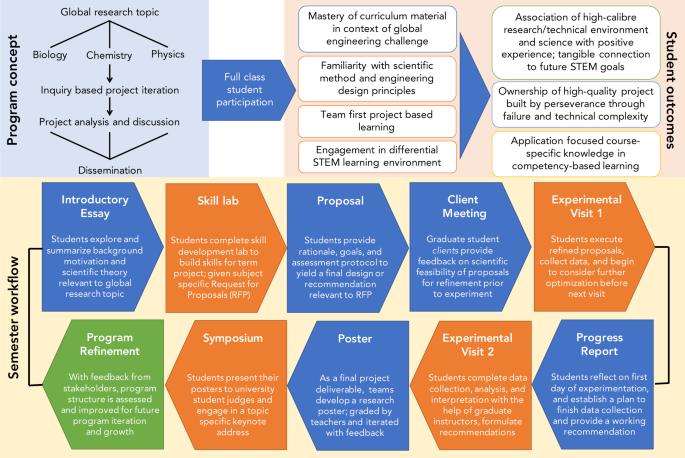
The general program concept (blue background; top left ) highlights a global research topic examined through student dissemination of subject-specific research questions, yielding multifaceted student outcomes (orange background; top right ). Each program term (term workflow, yellow background; bottom panel ), students work on program deliverables in class (blue), iterate experimental outcomes within university facilities (orange), and are assessed accordingly at numerous deliverables in an inquiry-focused learning model.
Over the course of five terms there were 268 instances of tracked student participation, representing 170 individual students. Specifically, 94 students participated during only one term of programming, 57 students participated in two terms, 16 students participated in three terms, and 3 students participated in four terms. Multiple instances of participation represent students that enrol in more than one STEM class during their senior years of high school, or who participated in Grade 11 and subsequently Grade 12. Students were surveyed before and after each term to assess program effects on STEM interest and engagement. All grade-based assessments were performed by high school teachers for their respective STEM class cohorts using consistent grading rubrics and assignment structure. Here, we discuss the outcomes of student involvement in this experiential curriculum model.
Student performance and engagement
Student grades were assigned, collected, and anonymized by teachers for each Discovery deliverable (background essay, client meeting, proposal, progress report, poster, and final presentation). Teachers anonymized collective Discovery grades, the component deliverable grades thereof, final course grades, attendance in class and during programming, as well as incomplete classroom assignments, for comparative study purposes. Students performed significantly higher in their cumulative Discovery grade than in their cumulative classroom grade (final course grade less the Discovery contribution; p < 0.0001). Nevertheless, there was a highly significant correlation ( p < 0.0001) observed between the grade representing combined Discovery deliverables and the final course grade (Fig. 2a ). Further examination of the full dataset revealed two student cohorts of interest: the “Exceeds Expectations” (EE) subset (defined as those students who achieved ≥1 SD [18.0%] grade differential in Discovery over their final course grade; N = 99 instances), and the “Multiple Term” (MT) subset (defined as those students who participated in Discovery more than once; 76 individual students that collectively accounted for 174 single terms of assessment out of the 268 total student-terms delivered) (Fig. 2b, c ). These subsets were not unrelated; 46 individual students who had multiple experiences (60.5% of total MTs) exhibited at least one occasion in achieving a ≥18.0% grade differential. As students participated in group work, there was concern that lower-performing students might negatively influence the Discovery grade of higher-performing students (or vice versa). However, students were observed to self-organize into groups where all individuals received similar final overall course grades (Fig. 2d ), thereby alleviating these concerns.
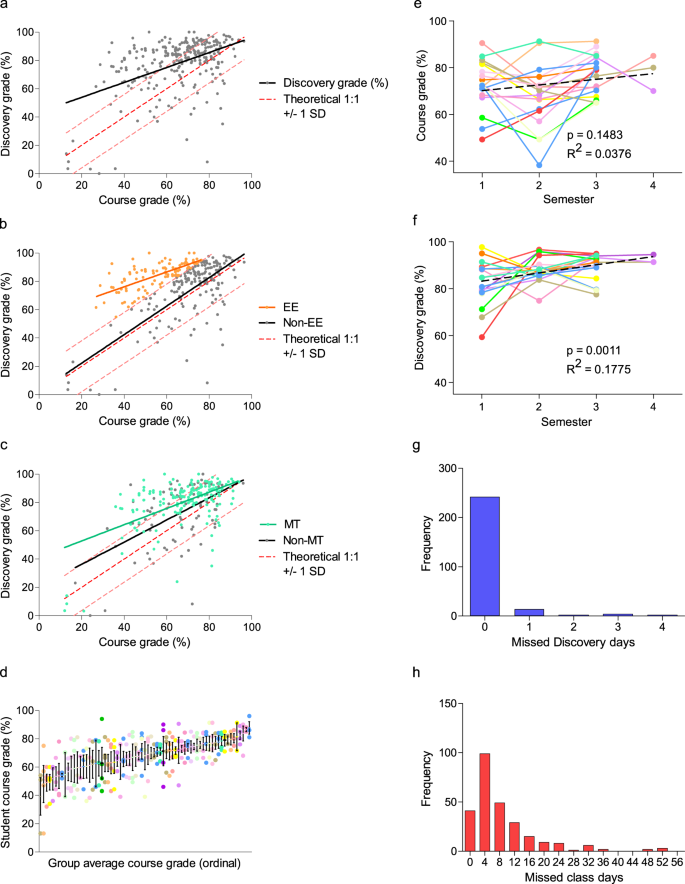
a Linear regression of student grades reveals a significant correlation ( p = 0.0009) between Discovery performance and final course grade less the Discovery contribution to grade, as assessed by teachers. The dashed red line and intervals represent the theoretical 1:1 correlation between Discovery and course grades and standard deviation of the Discovery -course grade differential, respectively. b , c Identification of subgroups of interest, Exceeds Expectations (EE; N = 99, orange ) who were ≥+1 SD in Discovery -course grade differential and Multi-Term (MT; N = 174, teal ), of which N = 65 students were present in both subgroups. d Students tended to self-assemble in working groups according to their final course performance; data presented as mean ± SEM. e For MT students participating at least 3 terms in Discovery , there was no significant correlation between course grade and time, while ( f ) there was a significant correlation between Discovery grade and cumulative terms in the program. Histograms of total absences per student in ( g ) Discovery and ( h ) class (binned by 4 days to be equivalent in time to a single Discovery absence).
The benefits experienced by MT students seemed progressive; MT students that participated in 3 or 4 terms ( N = 16 and 3, respectively ) showed no significant increase by linear regression in their course grade over time ( p = 0.15, Fig. 2e ), but did show a significant increase in their Discovery grades ( p = 0.0011, Fig. 2f ). Finally, students demonstrated excellent Discovery attendance; at least 91% of participants attended all Discovery sessions in a given term (Fig. 2g ). In contrast, class attendance rates reveal a much wider distribution where 60.8% (163 out of 268 students) missed more than 4 classes (equivalent in learning time to one Discovery session) and 14.6% (39 out of 268 students) missed 16 or more classes (equivalent in learning time to an entire program of Discovery ) in a term (Fig. 2h ).
Discovery EE students (Fig. 3 ), roughly by definition, obtained lower course grades ( p < 0.0001, Fig. 3a ) and higher final Discovery grades ( p = 0.0004, Fig. 3b ) than non-EE students. This cohort of students exhibited program grades higher than classmates (Fig. 3c–h ); these differences were significant in every category with the exception of essays, where they outperformed to a significantly lesser degree ( p = 0.097; Fig. 3c ). There was no statistically significant difference in EE vs. non-EE student classroom attendance ( p = 0.85; Fig. 3i, j ). There were only four single day absences in Discovery within the EE subset; however, this difference was not statistically significant ( p = 0.074).
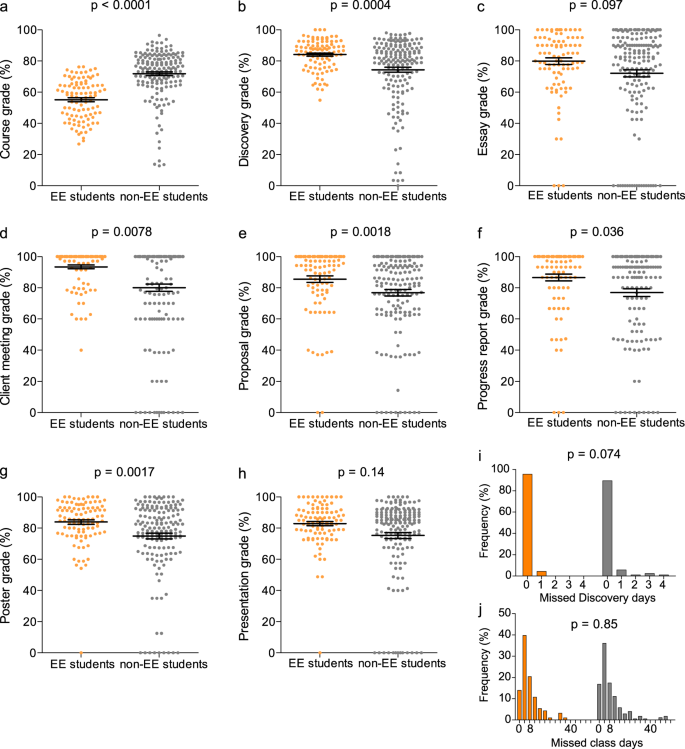
The “Exceeds Expectations” (EE) subset of students (defined as those who received a combined Discovery grade ≥1 SD (18.0%) higher than their final course grade) performed ( a ) lower on their final course grade and ( b ) higher in the Discovery program as a whole when compared to their classmates. d – h EE students received significantly higher grades on each Discovery deliverable than their classmates, except for their ( c ) introductory essays and ( h ) final presentations. The EE subset also tended ( i ) to have a higher relative rate of attendance during Discovery sessions but no difference in ( j ) classroom attendance. N = 99 EE students and 169 non-EE students (268 total). Grade data expressed as mean ± SEM.
Discovery MT students (Fig. 4 ), although not receiving significantly higher grades in class than students participating in the program only one time ( p = 0.29, Fig. 4a ), were observed to obtain higher final Discovery grades than single-term students ( p = 0.0067, Fig. 4b ). Although trends were less pronounced for individual MT student deliverables (Fig. 4c–h ), this student group performed significantly better on the progress report ( p = 0.0021; Fig. 4f ). Trends of higher performance were observed for initial proposals and final presentations ( p = 0.081 and 0.056, respectively; Fig. 4e, h ); all other deliverables were not significantly different between MT and non-MT students (Fig. 4c, d, g ). Attendance in Discovery ( p = 0.22) was also not significantly different between MT and non-MT students, although MT students did miss significantly less class time ( p = 0.010) (Fig. 4i, j ). Longitudinal assessment of individual deliverables for MT students that participated in three or more Discovery terms (Fig. 5 ) further highlights trend in improvement (Fig. 2f ). Greater performance over terms of participation was observed for essay ( p = 0.0295, Fig. 5a ), client meeting ( p = 0.0003, Fig. 5b ), proposal ( p = 0.0004, Fig. 5c ), progress report ( p = 0.16, Fig. 5d ), poster ( p = 0.0005, Fig. 5e ), and presentation ( p = 0.0295, Fig. 5f ) deliverable grades; these trends were all significant with the exception of the progress report ( p = 0.16, Fig. 5d ) owing to strong performance in this deliverable in all terms.
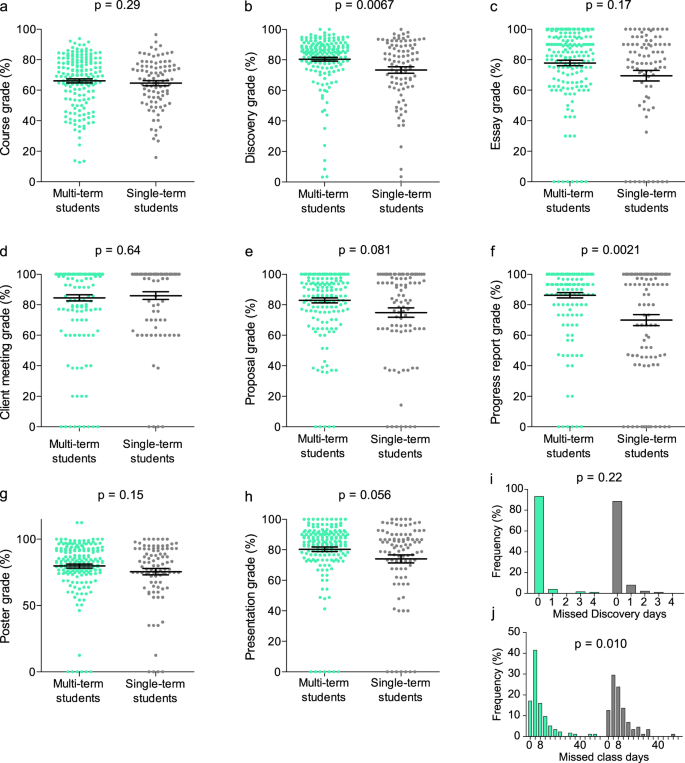
The “multi-term” (MT) subset of students (defined as having attended more than one term of Discovery ) demonstrated favorable performance in Discovery , ( a ) showing no difference in course grade compared to single-term students, but ( b outperforming them in final Discovery grade. Independent of the number of times participating in Discovery , MT students did not score significantly differently on their ( c ) essay, ( d ) client meeting, or ( g ) poster. They tended to outperform their single-term classmates on the ( e ) proposal and ( h ) final presentation and scored significantly higher on their ( f ) progress report. MT students showed no statistical difference in ( i ) Discovery attendance but did show ( j ) higher rates of classroom attendance than single-term students. N = 174 MT instances of student participation (76 individual students) and 94 single-term students. Grade data expressed as mean ± SEM.
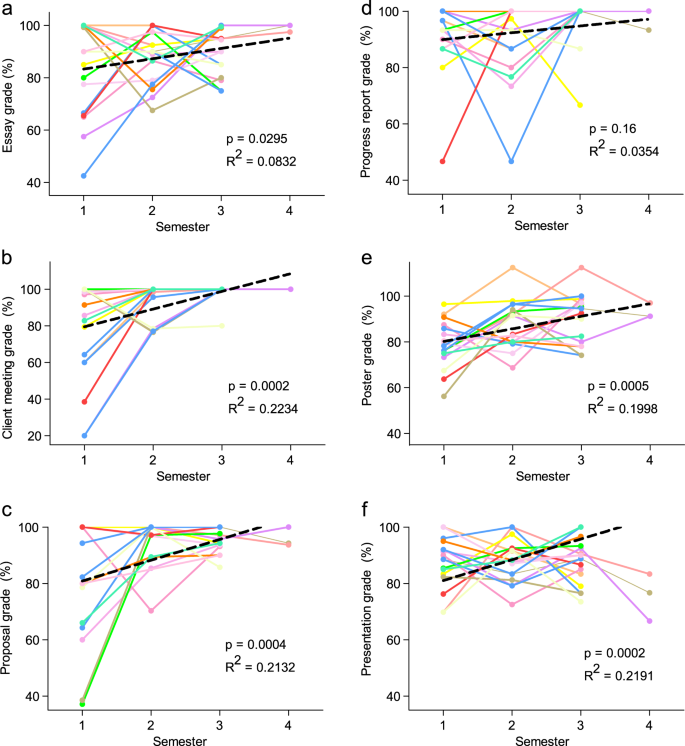
Longitudinal assessment of a subset of MT student participants that participated in three ( N = 16) or four ( N = 3) terms presents a significant trend of improvement in their ( a ) essay, ( b ) client meeting, ( c ) proposal, ( e ) poster, and ( f ) presentation grade. d Progress report grades present a trend in improvement but demonstrate strong performance in all terms, limiting potential for student improvement. Grade data are presented as individual student performance; each student is represented by one color; data is fitted with a linear trendline (black).
Finally, the expansion of Discovery to a second school of lower LOI (i.e., nominally higher aggregate SES) allowed for the assessment of program impact in a new population over 2 terms of programming. A significant ( p = 0.040) divergence in Discovery vs. course grade distribution from the theoretical 1:1 relationship was found in the new cohort (S 1 Appendix , Fig. S 1 ), in keeping with the pattern established in this study.
Teacher perceptions
Qualitative observation in the classroom by high school teachers emphasized the value students independently placed on program participation and deliverables. Throughout the term, students often prioritized Discovery group assignments over other tasks for their STEM courses, regardless of academic weight and/or due date. Comparing within this student population, teachers spoke of difficulties with late and incomplete assignments in the regular curriculum but found very few such instances with respect to Discovery -associated deliverables. Further, teachers speculated on the good behavior and focus of students in Discovery programming in contrast to attentiveness and behavior issues in their school classrooms. Multiple anecdotal examples were shared of renewed perception of student potential; students that exhibited poor academic performance in the classroom often engaged with high performance in this inquiry-focused atmosphere. Students appeared to take a sense of ownership, excitement, and pride in the setting of group projects oriented around scientific inquiry, discovery, and dissemination.
Student perceptions
Students were asked to consider and rank the academic difficulty (scale of 1–5, with 1 = not challenging and 5 = highly challenging) of the work they conducted within the Discovery learning model. Considering individual Discovery terms, at least 91% of students felt the curriculum to be sufficiently challenging with a 3/5 or higher ranking (Term 1: 87.5%, Term 2: 93.4%, Term 3: 85%, Term 4: 93.3%, Term 5: 100%), and a minimum of 58% of students indicating a 4/5 or higher ranking (Term 1: 58.3%, Term 2: 70.5%, Term 3: 67.5%, Term 4: 69.1%, Term 5: 86.4%) (Fig. 6a ).
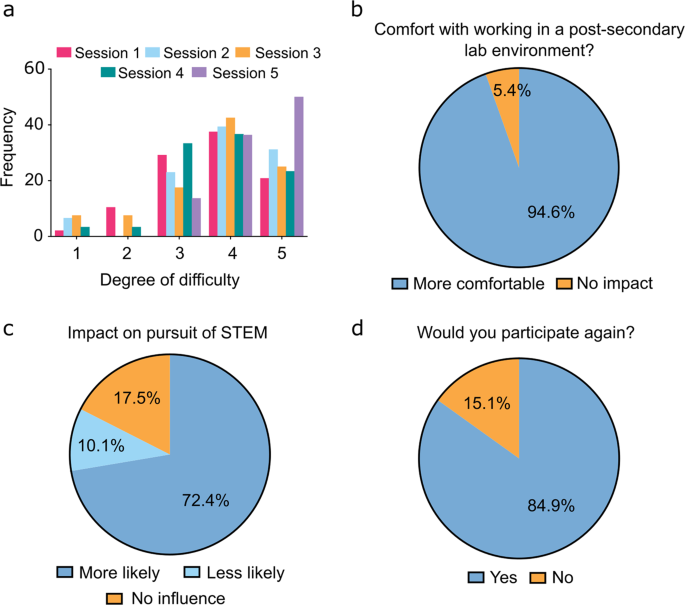
a Histogram of relative frequency of perceived Discovery programming academic difficulty ranked from not challenging (1) to highly challenging (5) for each session demonstrated the consistently perceived high degree of difficulty for Discovery programming (total responses: 223). b Program participation increased student comfort (94.6%) with navigating lab work in a university or college setting (total responses: 220). c Considering participation in Discovery programming, students indicated their increased (72.4%) or decreased (10.1%) likelihood to pursue future experiences in STEM as a measure of program impact (total responses: 217). d Large majority of participating students (84.9%) indicated their interest for future participation in Discovery (total responses: 212). Students were given the opportunity to opt out of individual survey questions, partially completed surveys were included in totals.
The majority of students (94.6%) indicated they felt more comfortable with the idea of performing future work in a university STEM laboratory environment given exposure to university teaching facilities throughout the program (Fig. 6b ). Students were also queried whether they were (i) more likely, (ii) less likely, or (iii) not impacted by their experience in the pursuit of STEM in the future. The majority of participants (>82%) perceived impact on STEM interests, with 72.4% indicating they were more likely to pursue these interests in the future (Fig. 6c ). When surveyed at the end of term, 84.9% of students indicated they would participate in the program again (Fig. 6d ).
We have described an inquiry-based framework for implementing experiential STEM education in a BME setting. Using this model, we engaged 268 instances of student participation (170 individual students who participated 1–4 times) over five terms in project-based learning wherein students worked in peer-based teams under the mentorship of U of T trainees to design and execute the scientific method in answering a relevant research question. Collaboration between high school teachers and Discovery instructors allowed for high school student exposure to cutting-edge BME research topics, participation in facilitated inquiry, and acquisition of knowledge through scientific discovery. All assessments were conducted by high school teachers and constituted a fraction (10–15%) of the overall course grade, instilling academic value for participating students. As such, students exhibited excitement to learn as well as commitment to their studies in the program.
Through our observations and analysis, we suggest there is value in differential learning environments for students that struggle in a knowledge acquisition-focused classroom setting. In general, we observed a high level of academic performance in Discovery programming (Fig. 2a ), which was highlighted exceptionally in EE students who exhibited greater academic performance in Discovery deliverables compared to normal coursework (>18% grade improvement in relevant deliverables). We initially considered whether this was the result of strong students influencing weaker students; however, group organization within each course suggests this is not the case (Fig. 2d ). With the exception of one class in one term (24 participants assigned by their teacher), students were allowed to self-organize into working groups and they chose to work with other students of relatively similar academic performance (as indicated by course grade), a trend observed in other studies 31 , 32 . Remarkably, EE students not only excelled during Discovery when compared to their own performance in class, but this cohort also achieved significantly higher average grades in each of the deliverables throughout the program when compared to the remaining Discovery cohort (Fig. 3 ). This data demonstrates the value of an inquiry-based learning environment compared to knowledge-focused delivery in the classroom in allowing students to excel. We expect that part of this engagement was resultant of student excitement with a novel learning opportunity. It is however a well-supported concept that students who struggle in traditional settings tend to demonstrate improved interest and motivation in STEM when given opportunity to interact in a hands-on fashion, which supports our outcomes 4 , 33 . Furthermore, these outcomes clearly represent variable student learning styles, where some students benefit from a greater exchange of information, knowledge and skills in a cooperative learning environment 34 . The performance of the EE group may not be by itself surprising, as the identification of the subset by definition required high performers in Discovery who did not have exceptionally high course grades; in addition, the final Discovery grade is dependent on the component assignment grades. However, the discrepancies between EE and non-EE groups attendance suggests that students were engaged by Discovery in a way that they were not by regular classroom curriculum.
In addition to quantified engagement in Discovery observed in academic performance, we believe remarkable attendance rates are indicative of the value students place in the differential learning structure. Given the differences in number of Discovery days and implications of missing one day of regular class compared to this immersive program, we acknowledge it is challenging to directly compare attendance data and therefore approximate this comparison with consideration of learning time equivalence. When combined with other subjective data including student focus, requests to work on Discovery during class time, and lack of discipline/behavior issues, the attendance data importantly suggests that students were especially engaged by the Discovery model. Further, we believe the increased commute time to the university campus (students are responsible for independent transit to campus, a much longer endeavour than the normal school commute), early program start time, and students’ lack of familiarity with the location are non-trivial considerations when determining the propensity of students to participate enthusiastically in Discovery . We feel this suggests the students place value on this team-focused learning and find it to be more applicable and meaningful to their interests.
Given post-secondary admission requirements for STEM programs, it would be prudent to think that students participating in multiple STEM classes across terms are the ones with the most inherent interest in post-secondary STEM programs. The MT subset, representing students who participated in Discovery for more than one term, averaged significantly higher final Discovery grades. The increase in the final Discovery grade was observed to result from a general confluence of improved performance over multiple deliverables and a continuous effort to improve in a STEM curriculum. This was reflected in longitudinal tracking of Discovery performance, where we observed a significant trend of improved performance. Interestingly, the high number of MT students who were included in the EE group suggests that students who had a keen interest in science enrolled in more than one course and in general responded well to the inquiry-based teaching method of Discovery , where scientific method was put into action. It stands to reason that students interested in science will continue to take STEM courses and will respond favorably to opportunities to put classroom theory to practical application.
The true value of an inquiry-based program such as Discovery may not be based in inspiring students to perform at a higher standard in STEM within the high school setting, as skills in critical thinking do not necessarily translate to knowledge-based assessment. Notably, students found the programming equally challenging throughout each of the sequential sessions, perhaps somewhat surprising considering the increasing number of repeat attendees in successive sessions (Fig. 6a ). Regardless of sub-discipline, there was an emphasis of perceived value demonstrated through student surveys where we observed indicated interest in STEM and comfort with laboratory work environments, and desire to engage in future iterations given the opportunity. Although non-quantitative, we perceive this as an indicator of significant student engagement, even though some participants did not yield academic success in the program and found it highly challenging given its ambiguity.
Although we observed that students become more certain of their direction in STEM, further longitudinal study is warranted to make claim of this outcome. Additionally, at this point in our assessment we cannot effectively assess the practical outcomes of participation, understanding that the immediate effects observed are subject to a number of factors associated with performance in the high school learning environment. Future studies that track graduates from this program will be prudent, in conjunction with an ever-growing dataset of assessment as well as surveys designed to better elucidate underlying perceptions and attitudes, to continue to understand the expected benefits of this inquiry-focused and partnered approach. Altogether, a multifaceted assessment of our early outcomes suggests significant value of an immersive and iterative interaction with STEM as part of the high school experience. A well-defined divergence from knowledge-based learning, focused on engagement in critical thinking development framed in the cutting-edge of STEM, may be an important step to broadening student perspectives.
In this study, we describe the short-term effects of an inquiry-based STEM educational experience on a cohort of secondary students attending a non-specialized school, and suggest that the framework can be widely applied across virtually all subjects where inquiry-driven and mentored projects can be undertaken. Although we have demonstrated replication in a second cohort of nominally higher SES (S 1 Appendix , Supplementary Fig. 1 ), a larger collection period with more students will be necessary to conclusively determine impact independent of both SES and specific cohort effects. Teachers may also find this framework difficult to implement depending on resources and/or institutional investment and support, particularly if post-secondary collaboration is inaccessible. Offerings to a specific subject (e.g., physics) where experiments yielding empirical data are logistically or financially simpler to perform may be valid routes of adoption as opposed to the current study where all subject cohorts were included.
As we consider Discovery in a bigger picture context, expansion and implementation of this model is translatable. Execution of the scientific method is an important aspect of citizen science, as the concepts of critical thing become ever-more important in a landscape of changing technological landscapes. Giving students critical thinking and problem-solving skills in their primary and secondary education provides value in the context of any career path. Further, we feel that this model is scalable across disciplines, STEM or otherwise, as a means of building the tools of inquiry. We have observed here the value of differential inclusive student engagement and critical thinking through an inquiry-focused model for a subset of students, but further to this an engagement, interest, and excitement across the body of student participants. As we educate the leaders of tomorrow, we suggest that use of an inquiry-focused model such as Discovery could facilitate growth of a data-driven critical thinking framework.
In conclusion, we have presented a model of inquiry-based STEM education for secondary students that emphasizes inclusion, quantitative analysis, and critical thinking. Student grades suggest significant performance benefits, and engagement data suggests positive student attitude despite the perceived challenges of the program. We also note a particular performance benefit to students who repeatedly engage in the program. This framework may carry benefits in a wide variety of settings and disciplines for enhancing student engagement and performance, particularly in non-specialized school environments.
Study design and implementation
Participants in Discovery include all students enrolled in university-stream Grade 11 or 12 biology, chemistry, or physics at the participating school over five consecutive terms (cohort summary shown in Table 1 ). Although student participation in educational content was mandatory, student grades and survey responses (administered by high school teachers) were collected from only those students with parent or guardian consent. Teachers replaced each student name with a unique coded identifier to preserve anonymity but enable individual student tracking over multiple terms. All data collected were analyzed without any exclusions save for missing survey responses; no power analysis was performed prior to data collection.
Ethics statement
This study was approved by the University of Toronto Health Sciences Research Ethics Board (Protocol # 34825) and the Toronto District School Board External Research Review Committee (Protocol # 2017-2018-20). Written informed consent was collected from parents or guardians of participating students prior to the acquisition of student data (both post-hoc academic data and survey administration). Data were anonymized by high school teachers for maintenance of academic confidentiality of individual students prior to release to U of T researchers.
Educational program overview
Students enrolled in university-preparatory STEM classes at the participating school completed a term-long project under the guidance of graduate student instructors and undergraduate student mentors as a mandatory component of their respective course. Project curriculum developed collaboratively between graduate students and participating high school teachers was delivered within U of T Faculty of Applied Science & Engineering (FASE) teaching facilities. Participation allows high school students to garner a better understanding as to how undergraduate learning and career workflows in STEM vary from traditional high school classroom learning, meanwhile reinforcing the benefits of problem solving, perseverance, teamwork, and creative thinking competencies. Given that Discovery was a mandatory component of course curriculum, students participated as class cohorts and addressed questions specific to their course subject knowledge base but related to the defined global health research topic (Fig. 1 ). Assessment of program deliverables was collectively assigned to represent 10–15% of the final course grade for each subject at the discretion of the respective STEM teacher.
The Discovery program framework was developed, prior to initiation of student assessment, in collaboration with one high school selected from the local public school board over a 1.5 year period of time. This partner school consistently scores highly (top decile) in the school board’s Learning Opportunities Index (LOI). The LOI ranks each school based on measures of external challenges affecting its student population therefore schools with the greatest level of external challenge receive a higher ranking 35 . A high LOI ranking is inversely correlated with socioeconomic status (SES); therefore, participating students are identified as having a significant number of external challenges that may affect their academic success. The mandatory nature of program participation was established to reach highly capable students who may be reluctant to engage on their own initiative, as a means of enhancing the inclusivity and impact of the program. The selected school partner is located within a reasonable geographical radius of our campus (i.e., ~40 min transit time from school to campus). This is relevant as participating students are required to independently commute to campus for Discovery hands-on experiences.
Each program term of Discovery corresponds with a five-month high school term. Lead university trainee instructors (3–6 each term) engaged with high school teachers 1–2 months in advance of high school student engagement to discern a relevant overarching global healthcare theme. Each theme was selected with consideration of (a) topics that university faculty identify as cutting-edge biomedical research, (b) expertise that Discovery instructors provide, and (c) capacity to showcase the diversity of BME. Each theme was sub-divided into STEM subject-specific research questions aligning with provincial Ministry of Education curriculum concepts for university-preparatory Biology, Chemistry, and Physics 9 that students worked to address, both on-campus and in-class, during a term-long project. The Discovery framework therefore provides students a problem-based learning experience reflective of an engineering capstone design project, including a motivating scientific problem (i.e., global topic), subject-specific research question, and systematic determination of a professional recommendation addressing the needs of the presented problem.
Discovery instructors were volunteers recruited primarily from graduate and undergraduate BME programs in the FASE. Instructors were organized into subject-specific instructional teams based on laboratory skills, teaching experience, and research expertise. The lead instructors of each subject (the identified 1–2 trainees that built curriculum with high school teachers) were responsible to organize the remaining team members as mentors for specific student groups over the course of the program term (~1:8 mentor to student ratio).
All Discovery instructors were familiarized with program expectations and trained in relevant workspace safety, in addition to engagement at a teaching workshop delivered by the Faculty Advisor (a Teaching Stream faculty member) at the onset of term. This workshop was designed to provide practical information on teaching and was co-developed with high school teachers based on their extensive training and experience in fundamental teaching methods. In addition, group mentors received hands-on training and guidance from lead instructors regarding the specific activities outlined for their respective subject programming (an exemplary term of student programming is available in S 2 Appendix) .
Discovery instructors were responsible for introducing relevant STEM skills and mentoring high school students for the duration of their projects, with support and mentorship from the Faculty Mentor. Each instructor worked exclusively throughout the term with the student groups to which they had been assigned, ensuring consistent mentorship across all disciplinary components of the project. In addition to further supporting university trainees in on-campus mentorship, high school teachers were responsible for academic assessment of all student program deliverables (Fig. 1 ; the standardized grade distribution available in S 3 Appendix ). Importantly, trainees never engaged in deliverable assessment; for continuity of overall course assessment, this remained the responsibility of the relevant teacher for each student cohort.
Throughout each term, students engaged within the university facilities four times. The first three sessions included hands-on lab sessions while the fourth visit included a culminating symposium for students to present their scientific findings (Fig. 1 ). On average, there were 4–5 groups of students per subject (3–4 students per group; ~20 students/class). Discovery instructors worked exclusively with 1–2 groups each term in the capacity of mentor to monitor and guide student progress in all project deliverables.
After introducing the selected global research topic in class, teachers led students in completion of background research essays. Students subsequently engaged in a subject-relevant skill-building protocol during their first visit to university teaching laboratory facilities, allowing opportunity to understand analysis techniques and equipment relevant for their assessment projects. At completion of this session, student groups were presented with a subject-specific research question as well as the relevant laboratory inventory available for use during their projects. Armed with this information, student groups continued to work in their classroom setting to develop group-specific experimental plans. Teachers and Discovery instructors provided written and oral feedback, respectively , allowing students an opportunity to revise their plans in class prior to on-campus experimental execution.
Once at the relevant laboratory environment, student groups executed their protocols in an effort to collect experimental data. Data analysis was performed in the classroom and students learned by trial & error to optimize their protocols before returning to the university lab for a second opportunity of data collection. All methods and data were re-analyzed in class in order for students to create a scientific poster for the purpose of study/experience dissemination. During a final visit to campus, all groups presented their findings at a research symposium, allowing students to verbally defend their process, analyses, interpretations, and design recommendations to a diverse audience including peers, STEM teachers, undergraduate and graduate university students, postdoctoral fellows and U of T faculty.
Data collection
Teachers evaluated their students on the following associated deliverables: (i) global theme background research essay; (ii) experimental plan; (iii) progress report; (iv) final poster content and presentation; and (v) attendance. For research purposes, these grades were examined individually and also as a collective Discovery program grade for each student. For students consenting to participation in the research study, all Discovery grades were anonymized by the classroom teacher before being shared with study authors. Each student was assigned a code by the teacher for direct comparison of deliverable outcomes and survey responses. All instances of “Final course grade” represent the prorated course grade without the Discovery component, to prevent confounding of quantitative analyses.
Survey instruments were used to gain insight into student attitudes and perceptions of STEM and post-secondary study, as well as Discovery program experience and impact (S 4 Appendix ). High school teachers administered surveys in the classroom only to students supported by parental permission. Pre-program surveys were completed at minimum 1 week prior to program initiation each term and exit surveys were completed at maximum 2 weeks post- Discovery term completion. Surveys results were validated using a principal component analysis (S 1 Appendix , Supplementary Fig. 2 ).
Identification and comparison of population subsets
From initial analysis, we identified two student subpopulations of particular interest: students who performed ≥1 SD [18.0%] or greater in the collective Discovery components of the course compared to their final course grade (“EE”), and students who participated in Discovery more than once (“MT”). These groups were compared individually against the rest of the respective Discovery population (“non-EE” and “non-MT”, respectively ). Additionally, MT students who participated in three or four (the maximum observed) terms of Discovery were assessed for longitudinal changes to performance in their course and Discovery grades. Comparisons were made for all Discovery deliverables (introductory essay, client meeting, proposal, progress report, poster, and presentation), final Discovery grade, final course grade, Discovery attendance, and overall attendance.
Statistical analysis
Student course grades were analyzed in all instances without the Discovery contribution (calculated from all deliverable component grades and ranging from 10 to 15% of final course grade depending on class and year) to prevent correlation. Aggregate course grades and Discovery grades were first compared by paired t-test, matching each student’s course grade to their Discovery grade for the term. Student performance in Discovery ( N = 268 instances of student participation, comprising 170 individual students that participated 1–4 times) was initially assessed in a linear regression of Discovery grade vs. final course grade. Trends in course and Discovery performance over time for students participating 3 or 4 terms ( N = 16 and 3 individuals, respectively ) were also assessed by linear regression. For subpopulation analysis (EE and MT, N = 99 instances from 81 individuals and 174 instances from 76 individuals, respectively ), each dataset was tested for normality using the D’Agostino and Pearson omnibus normality test. All subgroup comparisons vs. the remaining population were performed by Mann–Whitney U -test. Data are plotted as individual points with mean ± SEM overlaid (grades), or in histogram bins of 1 and 4 days, respectively , for Discovery and class attendance. Significance was set at α ≤ 0.05.
Reporting summary
Further information on research design is available in the Nature Research Reporting Summary linked to this article.
Data availability
The data that support the findings of this study are available upon reasonable request from the corresponding author DMK. These data are not publicly available due to privacy concerns of personal data according to the ethical research agreements supporting this study.
Holmes, K., Gore, J., Smith, M. & Lloyd, A. An integrated analysis of school students’ aspirations for STEM careers: Which student and school factors are most predictive? Int. J. Sci. Math. Educ. 16 , 655–675 (2018).
Article Google Scholar
Dooley, M., Payne, A., Steffler, M. & Wagner, J. Understanding the STEM path through high school and into university programs. Can. Public Policy 43 , 1–16 (2017).
Gilmore, M. W. Improvement of STEM education: experiential learning is the key. Mod. Chem. Appl. 1, e109. https://doi.org/10.4172/2329-6798.1000e109 (2013).
Roberts, T. et al. Students’ perceptions of STEM learning after participating in a summer informal learning experience. Int. J. STEM Educ. 5 , 35 (2018).
Gillies, R. M. & Boyle, M. Teachers’ reflections on cooperative learning: Issues of implementation. Teach. Teach. Educ. 26 , 933–940 (2010).
Nasir, M., Seta, J. & Meyer, E.G. Introducing high school students to biomedical engineering through summer camps. Paper presented at the ASEE Annual Conference & Exposition, Indianapolis, IN. https://doi.org/10.18260/1-2-20701 (2014).
Sadler, P. M., Sonnert, G., Hazari, Z. & Tai, R. Stability and volatility of STEM career interest in high school: a gender study. Sci. Educ. 96 , 411–427 (2012).
Sarikas, C. The High School Science Classes You Should Take . https://blog.prepscholar.com/the-high-school-science-classes-you-should-take (2020).
Ontario, G. o. The ontario curriculum grades 11 and 12. Science http://www.edu.gov.on.ca/eng/curriculum/secondary/2009science11_12.pdf (2008).
Scott, C. An investigation of science, technology, engineering and mathematics (STEM) focused high schools in the US. J. STEM Educ.: Innov. Res. 13 , 30 (2012).
Google Scholar
Erdogan, N. & Stuessy, C. L. Modeling successful STEM high schools in the United States: an ecology framework. Int. J. Educ. Math., Sci. Technol. 3 , 77–92 (2015).
Pfeiffer, S. I., Overstreet, J. M. & Park, A. The state of science and mathematics education in state-supported residential academies: a nationwide survey. Roeper Rev. 32 , 25–31 (2009).
Anthony, A. B., Greene, H., Post, P. E., Parkhurst, A. & Zhan, X. Preparing university students to lead K-12 engineering outreach programmes: a design experiment. Eur. J. Eng. Educ. 41 , 623–637 (2016).
Brown, J. S., Collins, A. & Duguid, P. Situated cognition and the culture of learning. Educ. researcher 18 , 32–42 (1989).
Reveles, J. M. & Brown, B. A. Contextual shifting: teachers emphasizing students’ academic identity to promote scientific literacy. Sci. Educ. 92 , 1015–1041 (2008).
Adedokun, O. A., Bessenbacher, A. B., Parker, L. C., Kirkham, L. L. & Burgess, W. D. Research skills and STEM undergraduate research students’ aspirations for research careers: mediating effects of research self-efficacy. J. Res. Sci. Teach. 50 , 940–951 (2013).
Boekaerts, M. Self-regulated learning: a new concept embraced by researchers, policy makers, educators, teachers, and students. Learn. Instr. 7 , 161–186 (1997).
Honey, M., Pearson, G. & Schweingruber, H. STEM Integration in K-12 Education: Status, Prospects, and An Agenda for Research . (National Academies Press, Washington, DC, 2014).
Moote, J. K., Williams, J. M. & Sproule, J. When students take control: investigating the impact of the crest inquiry-based learning program on self-regulated processes and related motivations in young science students. J. Cogn. Educ. Psychol. 12 , 178–196 (2013).
Fantz, T. D., Siller, T. J. & Demiranda, M. A. Pre-collegiate factors influencing the self-efficacy of engineering students. J. Eng. Educ. 100 , 604–623 (2011).
Ralston, P. A., Hieb, J. L. & Rivoli, G. Partnerships and experience in building STEM pipelines. J. Professional Issues Eng. Educ. Pract. 139 , 156–162 (2012).
Kelley, T. R. & Knowles, J. G. A conceptual framework for integrated STEM education. Int. J. STEM Educ. 3 , 11 (2016).
Brown, P. L., Concannon, J. P., Marx, D., Donaldson, C. W. & Black, A. An examination of middle school students’ STEM self-efficacy with relation to interest and perceptions of STEM. J. STEM Educ.: Innov. Res. 17 , 27–38 (2016).
Bandura, A., Barbaranelli, C., Caprara, G. V. & Pastorelli, C. Self-efficacy beliefs as shapers of children’s aspirations and career trajectories. Child Dev. 72 , 187–206 (2001).
Article CAS Google Scholar
Davenport Huyer, L. et al. IBBME discovery: biomedical engineering-based iterative learning in a high school STEM curriculum (evaluation). Paper presented at ASEE Annual Conference & Exposition, Salt Lake City, UT. https://doi.org/10.18260/1-2-30591 (2018).
Abu-Faraj, Ziad O., ed. Handbook of research on biomedical engineering education and advanced bioengineering learning: interdisciplinary concepts: interdisciplinary concepts. Vol. 2. IGI Global (2012).
Johri, A. & Olds, B. M. Situated engineering learning: bridging engineering education research and the learning sciences. J. Eng. Educ. 100 , 151–185 (2011).
O’Connell, K. B., Keys, B. & Storksdieck, M. Taking stock of oregon STEM hubs: accomplishments and challenges. Corvallis: Oregon State University https://ir.library.oregonstate.edu/concern/articles/hq37vt23t (2017).
Freeman, K. E., Alston, S. T. & Winborne, D. G. Do learning communities enhance the quality of students’ learning and motivation in STEM? J. Negro Educ. 77 , 227–240 (2008).
Weaver, R. R. & Qi, J. Classroom organization and participation: college students’ perceptions. J. High. Educ. 76 , 570–601 (2005).
Chapman, K. J., Meuter, M., Toy, D. & Wright, L. Can’t we pick our own groups? The influence of group selection method on group dynamics and outcomes. J. Manag. Educ. 30 , 557–569 (2006).
Hassaskhah, J. & Mozaffari, H. The impact of group formation method (student-selected vs. teacher-assigned) on group dynamics and group outcome in EFL creative writing. J. Lang. Teach. Res. 6 , 147–156 (2015).
Ma, V. J. & Ma, X. A comparative analysis of the relationship between learning styles and mathematics performance. Int. J. STEM Educ. 1 , 3 (2014).
Weinstein, C. E. & Hume, L. M. Study Strategies for Lifelong Learning . (American Psychological Association, 1998).
Toronto District School Board. The 2017 Learning Opportunities Index: Questions and Answers. https://www.tdsb.on.ca/Portals/research/docs/reports/LOI2017v2.pdf (2017).
Download references
Acknowledgements
This study has been possible due to the support of many University of Toronto trainee volunteers, including Genevieve Conant, Sherif Ramadan, Daniel Smieja, Rami Saab, Andrew Effat, Serena Mandla, Cindy Bui, Janice Wong, Dawn Bannerman, Allison Clement, Shouka Parvin Nejad, Nicolas Ivanov, Jose Cardenas, Huntley Chang, Romario Regeenes, Dr. Henrik Persson, Ali Mojdeh, Nhien Tran-Nguyen, Ileana Co, and Jonathan Rubianto. We further acknowledge the staff and administration of George Harvey Collegiate Institute and the Institute of Biomedical Engineering (IBME), as well as Benjamin Rocheleau and Madeleine Rocheleau for contributions to data collation. Discovery has grown with continued support of Dean Christopher Yip (Faculty of Applied Science and Engineering, U of T), and the financial support of the IBME and the National Science and Engineering Research Council (NSERC) PromoScience program (PROSC 515876-2017; IBME “Igniting Youth Curiosity in STEM” initiative co-directed by DMK and Dr. Penney Gilbert). LDH and NIC were supported by Vanier Canada graduate scholarships from the Canadian Institutes of Health Research and NSERC, respectively . DMK holds a Dean’s Emerging Innovation in Teaching Professorship in the Faculty of Engineering & Applied Science, U of T.
Author information
These authors contributed equally: Locke Davenport Huyer, Neal I. Callaghan.
Authors and Affiliations
Institute of Biomedical Engineering, University of Toronto, Toronto, ON, Canada
Locke Davenport Huyer, Neal I. Callaghan, Andrey I. Shukalyuk & Dawn M. Kilkenny
Chemical Engineering and Applied Chemistry, University of Toronto, Toronto, ON, Canada
Locke Davenport Huyer
Translational Biology and Engineering Program, Ted Rogers Centre for Heart Research, University of Toronto, Toronto, ON, Canada
Neal I. Callaghan
George Harvey Collegiate Institute, Toronto District School Board, Toronto, ON, Canada
Sara Dicks, Edward Scherer & Margaret Jou
Institute for Studies in Transdisciplinary Engineering Education & Practice, University of Toronto, Toronto, ON, Canada
Dawn M. Kilkenny
You can also search for this author in PubMed Google Scholar
Contributions
LDH, NIC and DMK conceived the program structure, designed the study, and interpreted the data. LDH and NIC ideated programming, coordinated execution, and performed all data analysis. SD, ES, and MJ designed and assessed student deliverables, collected data, and anonymized data for assessment. SD assisted in data interpretation. AIS assisted in programming ideation and design. All authors provided feedback and approved the manuscript that was written by LDH, NIC and DMK.
Corresponding author
Correspondence to Dawn M. Kilkenny .
Ethics declarations
Competing interests.
The authors declare no competing interests.
Additional information
Publisher’s note Springer Nature remains neutral with regard to jurisdictional claims in published maps and institutional affiliations.
Supplementary information
Supplemental material, reporting summary, rights and permissions.
Open Access This article is licensed under a Creative Commons Attribution 4.0 International License, which permits use, sharing, adaptation, distribution and reproduction in any medium or format, as long as you give appropriate credit to the original author(s) and the source, provide a link to the Creative Commons license, and indicate if changes were made. The images or other third party material in this article are included in the article’s Creative Commons license, unless indicated otherwise in a credit line to the material. If material is not included in the article’s Creative Commons license and your intended use is not permitted by statutory regulation or exceeds the permitted use, you will need to obtain permission directly from the copyright holder. To view a copy of this license, visit http://creativecommons.org/licenses/by/4.0/ .
Reprints and permissions
About this article
Cite this article.
Davenport Huyer, L., Callaghan, N.I., Dicks, S. et al. Enhancing senior high school student engagement and academic performance using an inclusive and scalable inquiry-based program. npj Sci. Learn. 5 , 17 (2020). https://doi.org/10.1038/s41539-020-00076-2
Download citation
Received : 05 December 2019
Accepted : 08 October 2020
Published : 02 December 2020
DOI : https://doi.org/10.1038/s41539-020-00076-2
Share this article
Anyone you share the following link with will be able to read this content:
Sorry, a shareable link is not currently available for this article.
Provided by the Springer Nature SharedIt content-sharing initiative
Quick links
- Explore articles by subject
- Guide to authors
- Editorial policies
Sign up for the Nature Briefing newsletter — what matters in science, free to your inbox daily.
- PRO Courses Guides New Tech Help Pro Expert Videos About wikiHow Pro Upgrade Sign In
- EDIT Edit this Article
- EXPLORE Tech Help Pro About Us Random Article Quizzes Request a New Article Community Dashboard This Or That Game Popular Categories Arts and Entertainment Artwork Books Movies Computers and Electronics Computers Phone Skills Technology Hacks Health Men's Health Mental Health Women's Health Relationships Dating Love Relationship Issues Hobbies and Crafts Crafts Drawing Games Education & Communication Communication Skills Personal Development Studying Personal Care and Style Fashion Hair Care Personal Hygiene Youth Personal Care School Stuff Dating All Categories Arts and Entertainment Finance and Business Home and Garden Relationship Quizzes Cars & Other Vehicles Food and Entertaining Personal Care and Style Sports and Fitness Computers and Electronics Health Pets and Animals Travel Education & Communication Hobbies and Crafts Philosophy and Religion Work World Family Life Holidays and Traditions Relationships Youth
- Browse Articles
- Learn Something New
- Quizzes Hot
- This Or That Game
- Train Your Brain
- Explore More
- Support wikiHow
- About wikiHow
- Log in / Sign up
- Education and Communications
- College University and Postgraduate
- Academic Writing
How to Write Any High School Essay
Last Updated: March 22, 2023 Fact Checked
This article was co-authored by Emily Listmann, MA and by wikiHow staff writer, Hunter Rising . Emily Listmann is a Private Tutor and Life Coach in Santa Cruz, California. In 2018, she founded Mindful & Well, a natural healing and wellness coaching service. She has worked as a Social Studies Teacher, Curriculum Coordinator, and an SAT Prep Teacher. She received her MA in Education from the Stanford Graduate School of Education in 2014. Emily also received her Wellness Coach Certificate from Cornell University and completed the Mindfulness Training by Mindful Schools. There are 14 references cited in this article, which can be found at the bottom of the page. This article has been fact-checked, ensuring the accuracy of any cited facts and confirming the authority of its sources. This article has been viewed 563,986 times.
Writing an essay is an important basic skill that you will need to succeed in high school and college. While essays will vary depending on your teacher and the assignment, most essays will follow the same basic structure. By supporting your thesis with information in your body paragraphs, you can successfully write an essay for any course!
Writing Help

Planning Your Essay

- Expository essays uses arguments to investigate and explain a topic.
- Persuasive essays try to convince the readers to believe or accept your specific point of view
- Narrative essays tell about a real-life personal experience.
- Descriptive essays are used to communicate deeper meaning through the use of descriptive words and sensory details.

- Look through books or use search engines online to look at the broad topic before narrowing your ideas down into something more concise.

- For example, the statement “Elephants are used to perform in circuses” does not offer an arguable point. Instead, you may try something like “Elephants should not be kept in the circus since they are mistreated.” This allows you to find supporting arguments or for others to argue against it.
- Keep in mind that some essay writing will not require an argument, such as a narrative essay. Instead, you might focus on a pivotal point in the story as your main claim.

- Talk to your school’s librarian for direction on specific books or databases you could use to find your information.
- Many schools offer access to online databases like EBSCO or JSTOR where you can find reliable information.
- Wikipedia is a great starting place for your research, but it can be edited by anyone in the world. Instead, look at the article’s references to find the sites where the information really came from.
- Use Google Scholar if you want to find peer-reviewed scholarly articles for your sources.
- Make sure to consider the author’s credibility when reviewing sources. If a source does not include the author’s name, then it might not be a good option.

- Outlines will vary in size or length depending on how long your essay needs to be. Longer essays will have more body paragraphs to support your arguments.
Starting an Essay

- Make sure your quotes or information are accurate and not an exaggeration of the truth, or else readers will question your validity throughout the rest of your essay.

- For example, “Because global warming is causing the polar ice caps to melt, we need to eliminate our reliance on fossil fuels within the next 5 years.” Or, “Since flavored tobacco appeals mainly to children and teens, it should be illegal for tobacco manufacturers to sell these products.”
- The thesis is usually the last or second to last sentence in your introduction.

- Use the main topics of your body paragraphs as an idea of what to include in your mini-outline.

Writing the Body Paragraphs

- Think of your topic sentences as mini-theses so your paragraphs only argue a specific point.

- Many high school essays are written in MLA or APA style. Ask your teacher what format they want you to follow if it’s not specified.

- Unless you’re writing a personal essay, avoid the use of “I” statements since this could make your essay look less professional.

- For example, if your body paragraphs discuss similar points in a different way, you can use phrases like “in the same way,” “similarly,” and “just as” to start other body paragraphs.
- If you are posing different points, try phrases like “in spite of,” “in contrast,” or “however” to transition.
Concluding Your Essay

- For example, if your thesis was, “The cell phone is the most important invention in the past 30 years,” then you may restate the thesis in your conclusion like, “Due to the ability to communicate anywhere in the world and access information easily, the cell phone is a pivotal invention in human history.”
- If you’re only writing a 1-page paper, restating your main ideas isn’t necessary.

- For example, if you write an essay discussing the themes of a book, think about how the themes are affecting people’s lives today.

- Try to pick the same type of closing sentence as you used as your attention getter.

- Including a Works Cited page shows that the information you provided isn’t all your own and allows the reader to visit the sources to see the raw information for themselves.
- Avoid using online citation machines since they may be outdated.
Revising the Paper

- Have a peer or parent read through your essay to see if they understand what point you’re trying to make.

- For example, if your essay discusses the history of an event, make sure your sentences flow in a chronological way in the order the events happened.

- If you cut parts out of your essay, make sure to reread it to see if it affects the flow of how it reads.

Community Q&A
- Allow ample time to layout your essay before you get started writing. Thanks Helpful 2 Not Helpful 0
- If you have writer's block , take a break for a few minutes. Thanks Helpful 2 Not Helpful 2
- Check the rubric provided by your teacher and compare your essay to it. This helps you gauge what you need to include or change. Thanks Helpful 0 Not Helpful 1

- Avoid using plagiarism since this could result in academic consequences. Thanks Helpful 5 Not Helpful 1
You Might Also Like

- ↑ https://www.grammarly.com/blog/types-of-essays/
- ↑ https://writingcenter.unc.edu/tips-and-tools/thesis-statements/
- ↑ https://guides.libs.uga.edu/reliability
- ↑ https://facultyweb.ivcc.edu/rrambo/eng1001/outline.htm
- ↑ https://examples.yourdictionary.com/20-compelling-hook-examples-for-essays.html
- ↑ https://wts.indiana.edu/writing-guides/how-to-write-a-thesis-statement.html
- ↑ https://guidetogrammar.org/grammar/five_par.htm
- ↑ https://learning.hccs.edu/faculty/jason.laviolette/persuasive-essay-outline
- ↑ https://academicguides.waldenu.edu/writingcenter/paragraphs/topicsentences
- ↑ https://writingcenter.unc.edu/tips-and-tools/transitions/
- ↑ https://writingcenter.fas.harvard.edu/pages/ending-essay-conclusions
- ↑ https://libguides.newcastle.edu.au/how-to-write-an-essay/conclusion
- ↑ https://pitt.libguides.com/citationhelp
- ↑ https://writingcenter.unc.edu/tips-and-tools/revising-drafts/
About This Article

Writing good essays is an important skill to have in high school, and you can write a good one by planning it out and organizing it well. Before you start, do some research on your topic so you can come up with a strong, specific thesis statement, which is essentially the main argument of your essay. For instance, your thesis might be something like, “Elephants should not be kept in the circus because they are mistreated.” Once you have your thesis, outline the paragraphs for your essay. You should have an introduction that includes your thesis, at least 3 body paragraphs that explain your main points, and a conclusion paragraph. Start each body paragraph with a topic sentence that states the main point of the paragraph. As you write your main points, make sure to include evidence and quotes from your research to back it up. To learn how to revise your paper, read more from our Writing co-author! Did this summary help you? Yes No
- Send fan mail to authors
Reader Success Stories
Ariel Arias Petzoldt
Aug 25, 2020
Did this article help you?

Nov 22, 2017
Rose Mpangala
Oct 24, 2018

Featured Articles


Trending Articles

Watch Articles

- Terms of Use
- Privacy Policy
- Do Not Sell or Share My Info
- Not Selling Info
wikiHow Tech Help Pro:
Level up your tech skills and stay ahead of the curve
Home — Essay Samples — Education — Why Is College Important — The Importance of College After High School: A Persuasive Paper
The Importance of College after High School: a Persuasive Paper
- Categories: College Education Why Is College Important
About this sample

Words: 598 |
Published: Jun 6, 2024
Words: 598 | Page: 1 | 3 min read
Table of contents
Introduction, body paragraph 1, body paragraph 2, body paragraph 3.

Cite this Essay
Let us write you an essay from scratch
- 450+ experts on 30 subjects ready to help
- Custom essay delivered in as few as 3 hours
Get high-quality help

Verified writer
- Expert in: Education

+ 120 experts online
By clicking “Check Writers’ Offers”, you agree to our terms of service and privacy policy . We’ll occasionally send you promo and account related email
No need to pay just yet!
Related Essays
2 pages / 811 words
3 pages / 1214 words
2 pages / 989 words
2 pages / 966 words
Remember! This is just a sample.
You can get your custom paper by one of our expert writers.
121 writers online
Still can’t find what you need?
Browse our vast selection of original essay samples, each expertly formatted and styled
Related Essays on Why Is College Important
The Path to Self-Actualization Discuss how a college education is a journey toward self-actualization and personal growth. How does it empower individuals to shape their own destinies and realize their full [...]
Rose, Mike. 'Why School? A Student in a Community College Basic Skills Program.' Why School?: Reclaiming Education for All of Us, The New Press, 2009.
Debates surrounding the value and relevance of higher education have intensified in recent years, prompting a reconsideration of the assertion that college is a waste of time and money. As the cost of tuition rises and [...]
Many people think college education in several individual terms that comes with it at the end. Parents and students have invested significant energy, time and resources in trying to build the future generations through [...]
“Education is the most powerful weapon which you can use to change the world.” These words of Nelson Mandela set the idea that with an education you can alter society for the better. Education is usually thought of as a tool to [...]
To answer the question “is college worth it?”, essay should provide persuasive arguments. In today’s world it is primarily essential for a high school student to continue their education to college. However, earning a Bachelor’s [...]
Related Topics
By clicking “Send”, you agree to our Terms of service and Privacy statement . We will occasionally send you account related emails.
Where do you want us to send this sample?
By clicking “Continue”, you agree to our terms of service and privacy policy.
Be careful. This essay is not unique
This essay was donated by a student and is likely to have been used and submitted before
Download this Sample
Free samples may contain mistakes and not unique parts
Sorry, we could not paraphrase this essay. Our professional writers can rewrite it and get you a unique paper.
Please check your inbox.
We can write you a custom essay that will follow your exact instructions and meet the deadlines. Let's fix your grades together!
Get Your Personalized Essay in 3 Hours or Less!
We use cookies to personalyze your web-site experience. By continuing we’ll assume you board with our cookie policy .
- Instructions Followed To The Letter
- Deadlines Met At Every Stage
- Unique And Plagiarism Free
US South Carolina
Recently viewed courses
Recently viewed.
Find Your Dream School
This site uses various technologies, as described in our Privacy Policy, for personalization, measuring website use/performance, and targeted advertising, which may include storing and sharing information about your site visit with third parties. By continuing to use this website you consent to our Privacy Policy and Terms of Use .
COVID-19 Update: To help students through this crisis, The Princeton Review will continue our "Enroll with Confidence" refund policies. For full details, please click here.
Enter your email to unlock an extra $25 off an SAT or ACT program!
By submitting my email address. i certify that i am 13 years of age or older, agree to recieve marketing email messages from the princeton review, and agree to terms of use., 5 ways college application essays and high school essays are different.
Are you a high school junior? Your college application is probably your first experience writing a personal statement. From purpose to audience, here’s a quick run-down of how college essays are different than the essays you write for English class.

High School Essay vs College Essay
1. understand purpose.
A high school essay generally demonstrates to your teacher what you know. An application essay should demonstrate who you are. Colleges want to find out what you're passionate about, and what you would add to the campus community.
2. Know your Audience
When your English teacher grades your essays, she puts them into the context of every interaction she’s ever had with you. Your personal statement is your one chance to speak directly to the admissions committee and demonstrate who you are beyond grades and test scores . Help colleges learn something about you that they cannot discover when reading the rest of your application. (Tip: Don’t treat your essay like a resume !)
Read More: Get Expert Essay Advice From Former Admissions Officers!
3. Show, Don't Summarize
College essay topics are often open-ended. (“Recount a time when you experienced failure.“) But at heart, all college essays are asking you to demonstrate the same things: your ability to reflect and think critically. Summaries are fine for book reports, but when writing your college essay take the opportunity to really examine how an experience taught you something you didn't previously know about yourself, got you out of your comfort zone, or forced you to grow.
4. Authenticity is Key
On a high school essay, it's generally not appropriate to use the first-person. Not only is it fine to make “I” statements in your application essays, but colleges expect your essays to sound like you, too! Always be yourself in your application, not the candidate you think admissions committees want to see.
5. Originality Counts
When your teacher asks you to analyze the causes of the Civil War, he is going to receive a lot of essays that sound basically the same. But your college essay should be unique and individual to you. College admissions officers tell us that they see many essays about eye-opening travel experiences, the death of a loved one, or “The Big Game.” You can still write about these experiences, but the trick is in the details. No one sees the world quite the way you do, so let your personality shine through.
Looking for strategic college advice?
Get one-on-one help from former Ivy League and top tier admission officers. Our College Admission Counselors will help you find, apply, and get accepted to your dream school.
- Applying to College

Explore Colleges For You
Connect with our featured colleges to find schools that both match your interests and are looking for students like you.

Career Quiz
Take our short quiz to learn which is the right career for you.

Get Started on Athletic Scholarships & Recruiting!
Join athletes who were discovered, recruited & often received scholarships after connecting with NCSA's 42,000 strong network of coaches.

Best 389 Colleges
165,000 students rate everything from their professors to their campus social scene.
SAT Prep Courses
1400+ course, act prep courses, free sat practice test & events, 1-800-2review, free digital sat prep try our self-paced plus program - for free, get a 14 day trial.

Free MCAT Practice Test
I already know my score.

MCAT Self-Paced 14-Day Free Trial

Enrollment Advisor
1-800-2REVIEW (800-273-8439) ext. 1
1-877-LEARN-30
Mon-Fri 9AM-10PM ET
Sat-Sun 9AM-8PM ET
Student Support
1-800-2REVIEW (800-273-8439) ext. 2
Mon-Fri 9AM-9PM ET
Sat-Sun 8:30AM-5PM ET
Partnerships
- Teach or Tutor for Us
College Readiness
International
Advertising
Affiliate/Other
- Enrollment Terms & Conditions
- Accessibility
- Cigna Medical Transparency in Coverage
Register Book
Local Offices: Mon-Fri 9AM-6PM
- SAT Subject Tests
Academic Subjects
- Social Studies
Find the Right College
- College Rankings
- College Advice
- Applying to College
- Financial Aid
School & District Partnerships
- Professional Development
- Advice Articles
- Private Tutoring
- Mobile Apps
- International Offices
- Work for Us
- Affiliate Program
- Partner with Us
- Advertise with Us
- International Partnerships
- Our Guarantees
- Accessibility – Canada
Privacy Policy | CA Privacy Notice | Do Not Sell or Share My Personal Information | Your Opt-Out Rights | Terms of Use | Site Map
©2024 TPR Education IP Holdings, LLC. All Rights Reserved. The Princeton Review is not affiliated with Princeton University
TPR Education, LLC (doing business as “The Princeton Review”) is controlled by Primavera Holdings Limited, a firm owned by Chinese nationals with a principal place of business in Hong Kong, China.

- About Michelle Waters
- Curriculum Vitae
- Tools I Use
- Podcast Episodes
- How To Be Our Podcast Guest
- Member Login
- Member Helpdesk
- Support Portal
- Resource Partners
- Writing Partners
- Certificate Verification
- How To Contribute
by Michelle Boyd Waters, M.Ed.
Essays Every High School Student Should Read
December 4, 2016 in Pedagogy
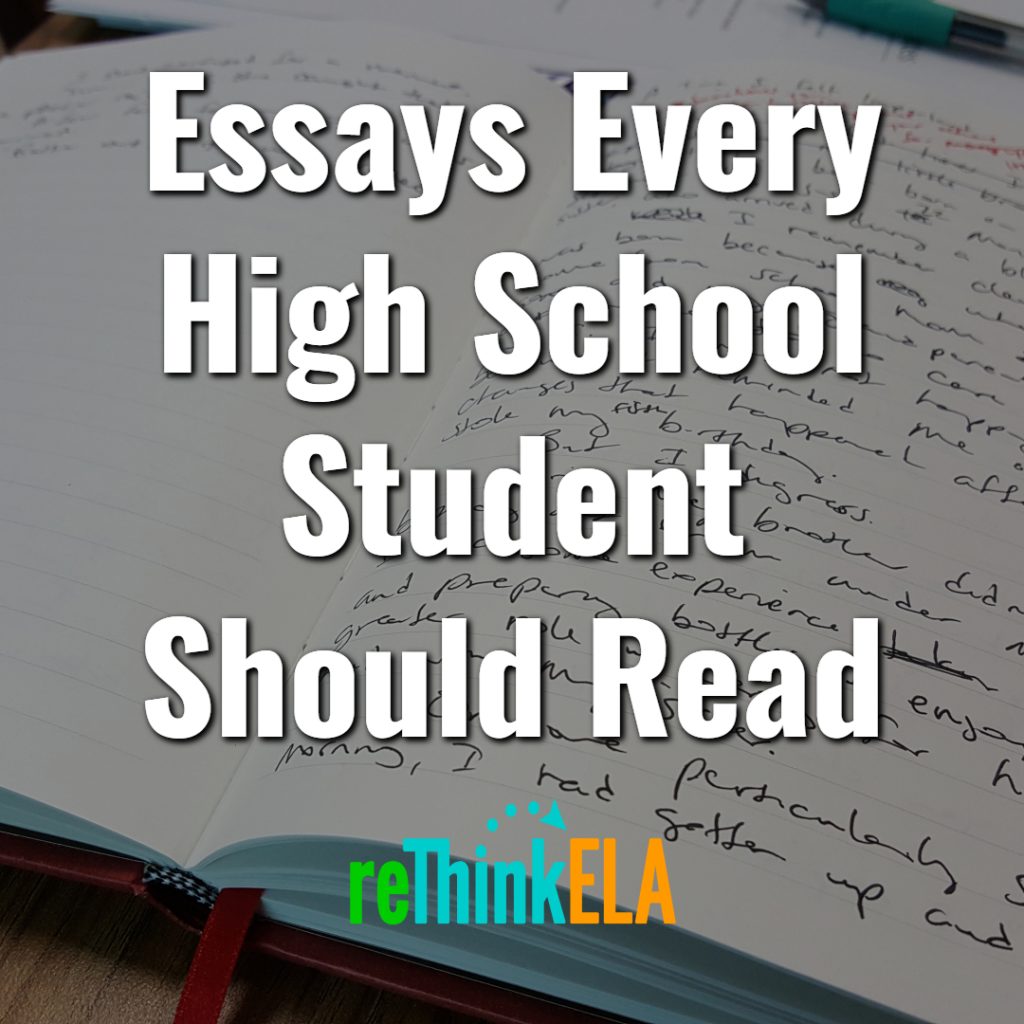
One of the most important goals of any English class should be to help students learn how to express themselves to an audience — how to tell their own stories, how to provide much-needed information, and how to convince others to see things from a different perspective.
Below are some essays students can read, not only to help them see how such writing is done in the real world, but also to learn more about the world around them.
[bctt tweet=”Need a #mentortext for student essays? Check out these exemplars for personal narrative, argumentative, and expository essay writing.”]
Note : This is a living list. I will continue adding to it as I find important essays and articles, and as my readers make suggestions.
If You Think Racism Doesn’t Exist by Jordan Womack | Lesson Plan
A 17-year-old Oklahoma author details incidents of discrimination he has faced within his own community. Brief, yet impactful, the author’s authenticity strikes readers at their core and naturally leads the audience to consider other perspectives.
Facebook hack ‘worse than when my house burned down’ says teacher by Michelle Boyd Waters, M.Ed.
When a hacker destroyed my Facebook account and I couldn’t find a way to reach out to Facebook, I decided to use my story, voice, and platform to shed light on a situation faced by people around the world. This can serve as a mentor text for students writing personal narratives on shared experiences in the context of current events.
Letter from a Vietnamese to an Iraqi Refugee by Andrew Lam
Vietnamese lecturer, journalist, and author Andrew Lam offers advice in this letter to a young Iraqi refugee he sees in a photograph on the Internet.
Allowing Teenage Boys to Love Their Friends by Jan Hoffman
Learn why early and lifelong friendships are as vital for boys as they are for girls and what happens when those friendships are fractured.
Chris Cecil: Plagiarism Gets You Fired by Leonard Pitts Jr
The Miami Herald columnist and 2004 Pulitzer Prize for Commentary winner castigates a Georgia newspaper editor for plagiarizing his work. This column would go great with this followup article from The Boston Globe: Ga. Editor is Fired for Lifting Columns .
Class Dismissed by Walter Kirn
The author of Lost in the Meritocracy postulates that getting rid of the high school senior year might be good for students.
Complaint Box | Packaging by Dylan Quinn
A high school junior complains about the impossible-to-open packaging faced by consumers of everything “from action figures to zip drives.”
Drowning in Dishes, but Finding a Home by Danial Adkison
In this 2014 essay, a teenager learns important lessons from his boss at Pizza Hut.
How to Tame a Wild Tongue by Gloria Anzaldua
An American scholar of Chicana cultural theory discusses how she maintained her identity by refusing to submit to linguistic terrorism.
Humble Beast: Samaje Perine by John Rohde
The five-time Oklahoma Sportswriter of the Year features the University of Oklahoma’s running back.
In Praise of the F Word by Mary Sherry
An adult literacy program teacher argues that allowing students to fail will actually help them.
The Joy of Reading and Writing: Superman and Me by Sherman Alexie
A Native American novelist recounts his experience loving reading and finally writing in spite of a culture that expected him to fail in the “non-Indian world” in order to be accepted.
Lane’s Legacy: One Final Ride by Keith Ryan Cartwright
A heartbreaking look back at the hours before and the circumstances surrounding Lane Frost’s untimely death, followed by reflections on his rise to fame — before and after death.
Learning to Read by Malcolm X
The 1960s Civil Rights leader writes about how educating himself in prison opened his mind and lead him to become one of the leading spokesmen for black separatism.
Learning to Read and Write by Frederick Douglass
A former slave born in 1818 discusses how he learned to read in spite of laws against teaching slaves and how reading opened his eyes to his “wretched condition, without remedy.”
Learning From Animal Friendships by Erica Goode
Scientists consider studying the phenomenon of cross-species animal friendships like the ones you see on YouTube.
Losing Everything, Except What Really Matters by Dan Barry
After a 2011 tornado destroys a house, but spares the family, a reporter writes about what’s important.
The Marked Woman by David Grann
How an Osage Indian family in Oklahoma became the prime target of one of the most sinister crimes in American history.
Meet Mikey, 8: U.S. Has Him on Watch List by Lizette Alvarez
Read about what happens if you happen to share a name of a “suspicious person” on the U.S. No-Fly List.
Newly Homeless in Japan Re-Establish Order Amid Chaos by Michael Wines
After the tsunami that resulted in nuclear disaster in 2011, a reporter writes about the “quiet bravery in the face of tragedy” of the Japanese people.
No Ordinary Joe by Rick Reilly
Why in creation did American Football Conference’s 1981 best young running back Joe Delaney jump into that pit full of water that day, even though he couldn’t swim?
Politics and the English Language By George Orwell
Animal Farm and 1984 author, Orwell correlates the degradation of the English language into multi-syllabic drivel and the corruption of the American political process.
Serving in Florida by Barbara Ehrenreich
The Nickel and Dimed: On (Not) Getting By in America author tells about her experiences attempting to survive on income of low-paying jobs.
Starvation Under the Orange Trees by John Steinbeck
John Steinbeck, who later authored the fictionalized account of Okies in California, The Grapes of Wrath, first wrote this essay documenting the starvation of migrant workers in California during the Great Depression.
To Fall in Love With Anyone, Do This by Mandy Len Catron
Is falling in love really a random event, or can two people “love smarter?”
We’ll Go Forward from this Moment by Leonard Pitts
The 2004 Pulitzer Prize for Commentary winner pens a column chronicling the toughness of the American family’s spirit in the face of the September 11, 2001 World Trade Center attacks. He wrote the column one day after the attacks.
What’s Wrong with Black English? by Rachel L. Jones
Jones, a student at Southern Illinois University in the 1980s, wrote this piece for Newsweek. In her essay, Jones adds her story and perspective to the debate over Black English.
Related topics: Mentor Texts , Teaching Writing
About the author
Michelle Boyd Waters, M.Ed.
I am a secondary English Language Arts teacher, a University of Oklahoma student working on my doctorate in Instructional Leadership and Academic Curriculum with an concentration in English Education and co-Editor of the Oklahoma English Journal. I am constantly seeking ways to amplify students' voices and choices.
A wonderful list of essays! I have neglected to teach essays as literature (only as student writing samples before we began work on an essay, after a novel). I’m looking forward to using these!
Thank you very much! I’d love to hear (or read) your feedback on the selections. Your input can help other teachers decide which essays to teach their students.
This list looks really great. Unfortunately, the first two links I chose were not working. One took me to a professors homepage and the other never opened.
Thank you for letting us know. I checked the “If you think racism doesn’t exist” went to the WordPress.com site where the author wrote his article and “Letter from a Vietnamese to an Iraqi Refugee” went to the Huffington Post article. Is it possible that your school web filter is blocking WordPress and Huffington Post?
Thank you for this. I am teaching a summer class that prepares 8th graders for high school essay writing. Trying to find a way to make it more creative and interesting, even interactive. I like the essays. If you have ideas about specific ways to use them, beyond reading and discussion, I would love to hear them.
You’re welcome! I think additional activities would depend on who your students are, their interests, and which essay(s) you plan to use. Perhaps if you join our RTE Facebook group and tell us about your kids and the essay you want to use, we can devise some activities to help them engage. Check us out here .
Comments are closed.
What are your chances of acceptance?
Calculate for all schools, your chance of acceptance.
Your chancing factors
Extracurriculars.
50 Engaging Narrative Essay Topics for High Schoolers
Do you know how to improve your profile for college applications.
See how your profile ranks among thousands of other students using CollegeVine. Calculate your chances at your dream schools and learn what areas you need to improve right now — it only takes 3 minutes and it's 100% free.
Show me what areas I need to improve
What’s Covered:
Narrative essays vs. analytical essays, how to pick the right narrative essay topic, elements of a strong narrative essay, engaging narrative essay topics for high schoolers, where to get your narrative essay edited for free.
Narrative essays are an extensive form of writing that gives readers the opportunity to follow along as a person goes through a journey or sets of experiences. Rather than providing analytic insight, narrative essays simply share a story and offer a first-person account. These essays may seem easy to write at first, but it takes a certain finesse to write a narrative essay that is interesting, cohesive, and well-researched. Whether you’re looking for a unique topic to write about, or just want some new inspiration, CollegeVine is here to help! These 50 narrative essay topics are engaging, unique and will have you writing in no time.
A narrative essay is a great way to express your personal experiences and opinions, but it is important to remember that this type of essay is different from an analytical paper. In a narrative essay, you do not need to provide background information or explain your thoughts and feelings; instead, you simply tell a story. It’s important to avoid too much telling in your writing; instead, use creative details and vivid imagery to make readers feel as if they are actually right there with you.
Where You Will Encounter Narrative Essays
This type of essay is typically encountered in high school, where students may be required to write personal statements to prepare for their Common App essay . Narrative essays are also commonly seen in AP Language and Composition. Therefore, it’s important you are aware of the style because you are bound to have a narrative essay assignment.
Of course, before you start writing, it is important to pick the right essay topic. There are many factors involved in the process of picking the perfect narrative essay topic for your story.
You should always choose a topic that you are passionate about, since writing on something you care about will make the process much easier. Not only will it be more interesting to create your paper around something that truly interests you, but it will also allow you to fully express yourself in your essay. You also want to be sure that the topic has enough material to work with. If your chosen topic is too short, you will not have enough content to write a complete paper. For example, if you are writing about your experience getting lost at the mall, make sure that you have enough information to work with to craft an engaging narrative.
The best topic for an engaging narrative essay is one that focuses on showing versus telling, has a clear structure, and provides a dialogue. These elements come together to form an engaging narrative essay. Regardless of what subject you pick, any topic may be turned into a fascinating, A+ worthy narrative using the tips below.
Show, Don’t Tell
To write a good narrative essay, it’s important to show, not tell. Instead of simply informing your audience, show them what you mean. For example, instead of saying “I was nervous,” you could say “My heart began to race and my stomach filled with butterflies.” Also make sure to use sensory details, such as sights, sounds and tastes, and include a personal reflection at the end of your narrative.
Begin with a Strong Opening Line
A good narrative essay will begin with an attention-grabbing opening line. But make sure to avoid common clichés, such as “It was the best of times, it was the worst of times.” Instead, come up with something original and specific to you and your situation. For example: “My pre-calc teacher was obsessed with circles. I mean, he even used circular note cards.” Or, “It all started the day my mom brought home a guinea pig.”
Follows a Three-Act Structure
A strong narrative essay follows the same three-act structure as other essays. But in order to make it interesting, you’ll need to come up with a creative way to break things down into sections. For example, using the guinea pig example from above, you could write the following:
- Act 1 – Introduction: The day my mom brought home a guinea pig.
- Act 2 – Conflict: The day I had to say goodbye to my beloved pet.
- Act 3 – Conclusion: Looking back at how much I miss him now that he’s gone.
Conclude with Personal Reflection
To conclude your narrative essay, you’ll want to explain what this specific experience taught you or how you’ve changed. For example, upon realizing that her pre-calc teacher was obsessed with circles, the writer of the previous example begins to notice circular shapes everywhere. Another way to conclude your narrative essay is by touching on how this experience impacted you emotionally. For example, after losing his guinea pig, the writer explains how much he missed it.
Use Dialogue
Include a conversation in your essay to make it come alive. For example, instead of simply saying that you met a new friend, talk about how you introduced yourselves or what they were wearing when you met them.

Discover your chances at hundreds of schools
Our free chancing engine takes into account your history, background, test scores, and extracurricular activities to show you your real chances of admission—and how to improve them.
The following list of 50 narrative essay topics is divided into categories. This will make it easier to find a topic that fits your writing style.
1. What is a childhood song that still sticks with you today?
2. Your first day of Kindergarten
3. Talk about a time when you’re siblings looked up to you
4. Describe the best birthday party you’ve ever had
5. Talk about the best day you ever spent with a childhood friend
6. Explain your first childhood hobby
7. Describe your first halloween costume
8. A family vacation gone wrong
9. Your first family reunion
10. Describe a tradition that is unique to your family
11. Describe your family to a person who’s never met them before
12. What frustrates you most about your family
13. If you could only keep one memory of your family, what would it be and why?
14. Describe a time your family embarrassed you in public
15. The most beautiful place in the world
16. Your favorite season and why
17. If you were a part of nature, what element would you be? Why?
18. When you go outside, which of your senses are you most thankful to have?
19. Describe the first time you witnessed a tornado
20. Write a poem about your favorite season
21. Describe yourself as one of the four seasons
22. Describe a time in which you felt connected with nature
23. Describe the first time you played an instrument and how you felt
24. What major event would be much worse if music was removed, and why?
25. If you could only listen to one song for the rest of your life, what would it be and why?
26. What would a life without music look like?
27. If you could master one instrument, what would it be and why?
Relationships
28. What if you had never met your best friend?
29. Describe a time when you fixed a broken relationship
30. Talk about a movie that defined a relationship for you
31. Describe your first date
32. Describe the first time you made a friend
33. Describe your relationship with your parents
Self Reflection
34. Have you ever fooled someone? If so, describe what happened and how you felt about it
35. What is the worst thing you’ve done to someone else?
36. Write about the difference between how things seem and how they really are.
37. Have you ever been embarrassed in some way? If so, describe the situation and how it affected you as well as those around you
38. Have you ever witnessed something really beautiful? Describe it
39. Is your glass half empty or half full?
Overcoming Adversity
40. Have you ever been very afraid of something but tried your hardest to appear fearless? If so, describe that experience
41. When have you ever succeeded when you thought you might fail
42. What are your secret survival strategies?
43. Describe the last time you were stressed and why?
44. Describe a time when you were discriminated against
45. The most memorable class you’ve had and why
46. Your favorite study abroad memory
47. Describe your kindergarten classroom
48. Describe your first teacher
49. The first time you experienced detention
50. Your first field trip
Hopefully these topics will get you thinking about a personal experience that could make for a thoughtful and engaging narrative essay. Remember, a strong narrative essay must contain relatable details and a clear flow that keeps the reader entertained and engaged to read all the way to the end.
If you need some additional guidance on your narrative essay, use CollegeVine’s free peer review essay tool to get feedback for free!
Related CollegeVine Blog Posts

- Grades 6-12
- School Leaders
NEW: Classroom Clean-Up/Set-Up Email Course! 🧽
The Ultimate Guide To Writing a Winning Scholarship Essay
Stand out from the rest.

With the cost of higher education skyrocketing in the last few decades, it’s no surprise that many students seek out scholarships to help cover tuition. As a result, it’s a very competitive endeavor, which is why students need to find ways to stand out. We’ve put together this resource to help write a scholarship essay that will get the application committee’s attention.
How To Find Scholarships
Many students know that they want to apply for scholarships but don’t know where to find them. Honestly, this can be the most difficult and intimidating part of the process for students! Here are some suggestions for where to start.
Ask a Guidance Counselor
One of the best resources for high school students is their guidance counselor. They are prepared to help students make academic and career plans and should be aware of scholarship opportunities to align with your needs and goals.
Talk to the College or University
Already have a college or university picked out? Reach out to the school’s financial aid department. In addition to the many scholarships you can find online, they may offer information about funding offered directly through the school.
Submit a FAFSA Application
Even if a student isn’t planning to accept student loans, they should definitely consider completing a Free Application for Federal Student Aid (FAFSA). Not only will the resulting report inform them of any financial assistance for which they qualify, but many scholarship committees require applicants to submit a FAFSA.
Search Scholarship Websites
There are many scholarship websites where students can find awards and applications. Sites such as Scholarships.com and Scholarship 360 allow you to use filters to narrow down your search results based on your needs and interests.
We’ve also put together the following guides:
- How To Get a Full-Ride Scholarship
- Best Merit-Based Scholarships
- Excellent Scholarships for High School Seniors
- Great Scholarships for Black Students
- Scholarships for Women
- Best Scholarship Opportunities for Future Teachers
Do an Internet Search
Head to a search engine, social media platform, or sites like Reddit to look for scholarships. You can even create posts inviting other users to share suggestions.
Ask an Employer
Some workplaces offer tuition benefits or other financial assistance for higher education. If a student is employed, it’s an option to reach out to someone in the HR department to see if they offer any programs or scholarships.
The Dos and Don’ts of Writing a Scholarship Essay
Do: know the rules.
The most important thing anyone can do before writing a scholarship essay is this: Read all of the rules and guidelines and then reread them! Students can even ask someone else to read them too, to make sure they fully understand what they need to do. Failing to follow the rules is one of the main reasons why students are unsuccessful in getting scholarships.
Do: Set Aside Plenty of Time
Start working on scholarship essays right away. Do not wait until a week (or day!) before the deadline. This gives students time to write several drafts of the essay if needed. Also, you never know when a technology-related issue might strike, so having a little extra time can save you from disaster.
Do: Research the Scholarship Provider
Dig deep when applying for a scholarship. Find out who is funding the award and spend some time researching the provider. Do they have a vision or mission statement? Do they support any specific causes or types of students? Is there any way that applicants can make themselves more attractive candidates for the specific audience? Students should use this information to their advantage!
Do: Brainstorm
Students should take some time to think about what they’ve learned about the scholarship essay guidelines and the provider. Then, brainstorm about what they want to say and share and why. Here are some questions to ask as they pertain to education and career goals:
- Who are you? Think of yourself but also your background.
- What makes you who you are?
- What have you done?
- What do you want to do?
- How are you going to get there?
- Why do you need a scholarship?
- How will it make a difference?
- Are you a first-generation college student?
- Do you have any unique qualities or needs?
- What makes you proud?
- What lessons have you learned?
These are heavy questions, but finding the answers to at least some of them will help provide the substance needed to write a truly effective scholarship essay.
Do: Find Ways To Stand Out
Many, many students are applying for scholarships. They have to find a way to stand out from the rest. Students should think of the things they learned when they researched the scholarship provider. Are there any ways they can appeal to that audience? If so, focus on those areas.
Do: Be Honest
Do not lie on a scholarship application. Let’s say that again: Do not lie on a scholarship application. Students should remind themselves that they are worthy on their own. If an applicant is discovered to be dishonest, it can really hurt them in the long run.
Do: Stay on Topic
When reading the guidelines for the scholarship and doing brainstorming, be sure to keep the topic of the essay in mind. Everything students share and communicate should be related to the topic.
Do: Be Professional
Students should use their very best skills when writing a scholarship essay. They should not use slang, casual language, unconventional fonts, emojis, or texting abbreviations.
Do: Proofread and Edit Multiple Times
It’s a good idea to prepare to write this essay at least three times. First, there’s a rough draft that should be carefully proofread. Students can ask a teacher or other professional to also look at their paper. Then students should repeat this process once or twice more until they’re happy with the results. They shouldn’t just write it and submit it all at once!
Don’t: Brag
While students want to highlight their strengths and accomplishments, they should not brag. They also don’t want to put down other candidates or people to make themselves look good. Tell a story without embellishments.
Don’t: Reuse a Scholarship Essay
Students put a lot of effort into writing scholarship essays, but please don’t reuse them!
Scholarship Essay Sample Outline
Ready to get started? Having a solid outline provides a road map for the journey. Here are some suggestions for making it easier to write a scholarship essay!
Introduction
Students should explain who they are and try to make it engaging. Hook readers by sharing a few details that will be elaborated on in the body of the essay.
Educational and Career Goals
Students should share what they want to study and hope to gain by getting an education, as well as how it will prepare them for their future career. They should be passionate!
Who Are You?
Student should briefly explain their background, which can include details about family, personal values, and how they got to where they are today.
Why Are You a Good Candidate for the Scholarship?
This is where students need to really think about what they learned about the scholarship provider. What are they looking for in a candidate? Students should do their best to not only shine as a good student and leader, but also find solid ways to connect with the scholarship provider’s mission. After including some teasers or breadcrumbs in the introduction to hook the reader, this is a good place to share the rest of the story.
To wrap up a scholarship essay, students should reiterate their commitment to their education and career. Restate how the story shared demonstrates a readiness for college and how winning the scholarship can help the applicant follow their dreams. Best of luck!
Do you have tips on how to write a scholarship essay? Share them below! Plus, check out The Ultimate Guide to College Scholarships!
Want more suggestions be sure to subscribe to our newsletters ..
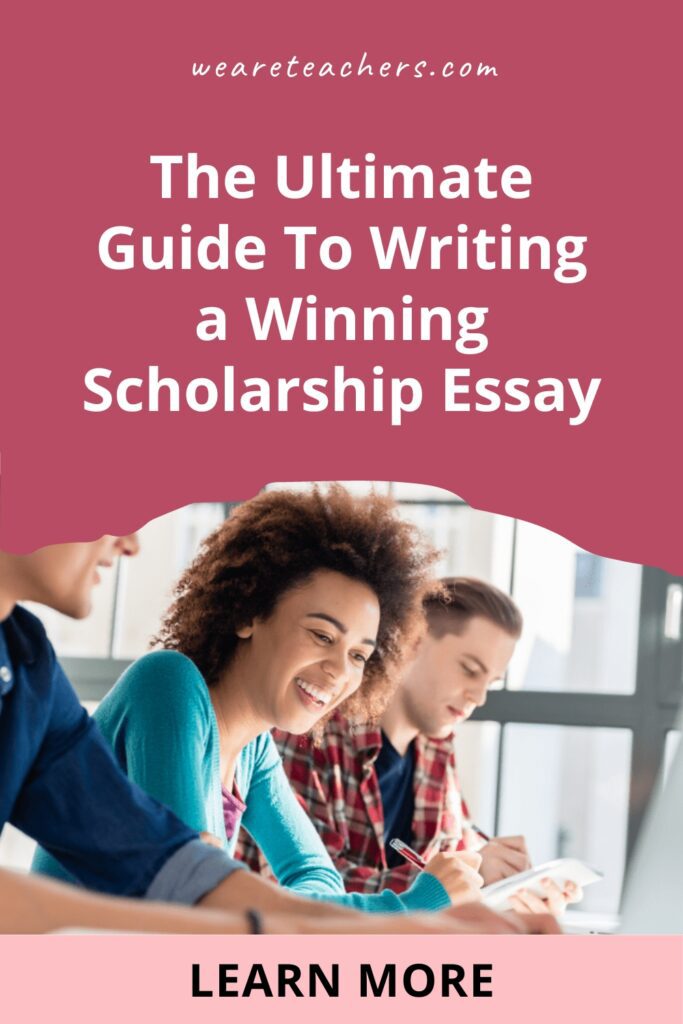
You Might Also Like
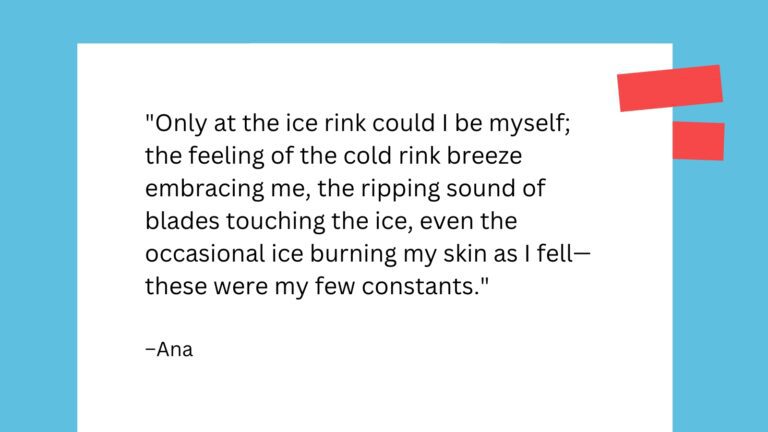
10 Winning Scholarship Essay Examples From Real Students
Make your application shine. Continue Reading
Copyright © 2024. All rights reserved. 5335 Gate Parkway, Jacksonville, FL 32256

Virtual Tour
Experience University of Idaho with a virtual tour. Explore now
- Discover a Career
- Find a Major
- Experience U of I Life
More Resources
- Admitted Students
- International Students
Take Action
- Find Financial Aid
- View Deadlines
- Find Your Rep

Helping to ensure U of I is a safe and engaging place for students to learn and be successful. Read about Title IX.
Get Involved
- Clubs & Volunteer Opportunities
- Recreation and Wellbeing
- Student Government
- Student Sustainability Cooperative
- Academic Assistance
- Safety & Security
- Career Services
- Health & Wellness Services
- Register for Classes
- Dates & Deadlines
- Financial Aid
- Sustainable Solutions
- U of I Library

- Upcoming Events
Review the events calendar.
Stay Connected
- Vandal Family Newsletter
- Here We Have Idaho Magazine
- Living on Campus
- Campus Safety
- About Moscow

The largest Vandal Family reunion of the year. Check dates.
Benefits and Services
- Vandal Voyagers Program
- Vandal License Plate
- Submit Class Notes
- Make a Gift
- View Events
- Alumni Chapters
- University Magazine
- Alumni Newsletter

U of I's web-based retention and advising tool provides an efficient way to guide and support students on their road to graduation. Login to VandalStar.
Common Tools
- Administrative Procedures Manual (APM)
- Class Schedule
- OIT Tech Support
- Academic Dates & Deadlines
- U of I Retirees Association
- Faculty Senate
- Staff Council
Office of Admissions
Physical Address: University of Idaho Bruce M. Pitman Center 709 Deakin Street Rm 117 Moscow, ID 83844
Mailing Address: University of Idaho 875 Perimeter Drive MS 4264 Moscow, ID 83844-4264
Phone: 208-885-6326
Fax: 208-885-9119
Email: [email protected]
Web: Office of Admissions
Physical Address: University of Idaho Boise 322 E. Front St Boise, ID 83702
Email: [email protected]
Web: Boise Center
Coeur d'Alene
Physical Address: University of Idaho Coeur d'Alene 1031 N Academic Way Suite 242 Coeur d'Alene, ID 83814
Web: Coeur d'Alene Center
Idaho Falls
Physical Address: University of Idaho Idaho Fall 1776 Science Center Dr. Suite 306 Idaho Falls, ID 83840
Web: Idaho Falls Center
First-Year Admission Requirements
First-Year students are those applying directly from high school or those applying with fewer than 14 semester credits of transferable college work earned after high school graduation.
Review First-Year Admission Requirements
Regionally accredited high school students.
First-year students who graduate from a regionally accredited high school must meet all admission requirements in effect for the year they graduated.
These students include:
- Those enrolling directly from high school.
- Those enrolling directly from high school who have completed college-level work while in high school.
Please note: Applicants with fewer than 14 transferable semester credits completed after high school graduation must also meet transfer GPA requirements.
Early admission may be granted based on a sixth or seventh semester high school transcript if it appears that the student will meet admission requirements.
You must submit:
- An application for admission .
- $50 application fee (nonrefundable). No application fee required for Idaho residents.
- ACT or SAT test scores. You may request copies of your ACT or SAT scores. If your ACT or SAT scores are on your school transcript, you do not need to have them sent separately. New first-year students entering in 2024 who do not provide test scores will automatically be considered for admission if their cumulative unweighted GPA is 2.60-4.00. Those who have cumulative GPAs of 2.30 - 2.59 will be admitted through the Vandal Gateway Program . Students in this GPA range are also welcome to appeal through our Admissions Committee . Every student who has a test score is encouraged to provide it for admission as well as class placement.
- Official high school transcript showing graduation date. If you have not yet graduated from high school, a transcript showing all completed work may be accepted for early admission.
- Official transcripts from any colleges or universities attended.
Academic requirements:
- Core requirements
- Combination of cumulative GPA and test scores
- Applicants with fewer than 14 transferable semester credits earned after high school graduation must also meet the admission requirements for new transfers .
If you do not meet the published criteria for admission at the time of review, you may apply to the Admissions Committee for consideration.
GED Students
First-Year students who have completed their GED instead of graduating from an accredited high school and have earned fewer than 14 transferable semester credits since obtaining their GED will have their application for admission referred to the Admissions Committee for a decision.
- ACT or SAT test scores. Please note: If you have an ACT composite of 26 or higher or an SAT Evidence Based Reading + Math score of 1260 or higher, you are not required to submit the letters of recommendation or the written statement referenced below.
- Official high school transcript showing the work completed. (Note: high school transcripts are required from any high school attended even though the student did not graduate.)
- A copy of the GED test results.
- Three signed letters of recommendation from individuals who can attest to the student's academic ability.
- A written statement from the student which includes the student's goals, educational and/or professional objectives, an explanation of past academic performance, information and/or documentation regarding any extenuating circumstances and any other information the student wishes to have considered.
Please note: Applicants with fewer than 14 transferable semester credits completed since obtaining their GED must also meet the admission requirements for new transfers.
Home-Schooled Students
First-year students who have been home-schooled either partially or completely for grades nine through 12 and have earned fewer than 14 transferable semester credits since graduating from home-school will have their application for admission referred to the Admissions Committee for a decision. You must submit:
- ACT or SAT test scores. Please note: If you have an ACT composite of 26 or higher or an SAT Evidence Based Reading + Math score of 1260 or higher, you are not required to submit the letters of recommendation or the written statement referenced below.
- Home-school transcript or a description of your educational background including subjects studied.
- Official transcripts from any secondary school attended prior to or in addition to home schooling.
- A copy of the GED test results if obtained.
- A written statement from the student that includes the student's goals, educational and/or professional objectives, an explanation of past academic performance, information and/or documentation regarding any extenuating circumstances and anything else the committee might find useful when reviewing your file.
Please note: Applicants with fewer than 14 transferable semester credits completed since graduating from home-school must also meet the admission requirements for new transfers .
Non-Accredited High School Students
First-year students who graduate from non-accredited high schools (high schools without accreditation from a regional accrediting agency such as the Northwest Association of Schools and Colleges) and have earned fewer than 14 transferable semester credits since graduating from high school will have their application for admission referred to the Admissions Committee for a decision. You must submit:
- ACT or SAT test scores. Please note: If you have an ACT composite of 26 or higher or an SAT Evidence Based Reading + Math score of 1260 or higher, you are not required to submit the letters of recommendation or the written statement referenced below.
- A copy of the GED test results if obtained.
Students with Fewer than 14 Transferable Credits
First-year students who have earned fewer than 14 transferable semester credits since high school graduation must meet both first-year and transfer admission requirements.
- ACT or SAT test scores. You may request copies of your ACT or SAT scores. If your ACT or SAT scores are on your school transcript, you do not need to have them sent separately. Students entering in 2024 who do not provide test scores will be considered for admission if their cumulative unweighted GPA is 2.60-4.00. Every student who has a test score is encouraged to provide it for admission as well as class placement.
- Official high school transcript showing graduation date.
Application Changes
NO application fee for Idaho residents!
Apply today
- Undergraduate Admission Application pdf
- Scholarship Supplement pdf
- Additional Information Form pdf
Purdue Online Writing Lab Purdue OWL® College of Liberal Arts
Welcome to the Purdue Online Writing Lab

Welcome to the Purdue OWL
This page is brought to you by the OWL at Purdue University. When printing this page, you must include the entire legal notice.
Copyright ©1995-2018 by The Writing Lab & The OWL at Purdue and Purdue University. All rights reserved. This material may not be published, reproduced, broadcast, rewritten, or redistributed without permission. Use of this site constitutes acceptance of our terms and conditions of fair use.
The Online Writing Lab at Purdue University houses writing resources and instructional material, and we provide these as a free service of the Writing Lab at Purdue. Students, members of the community, and users worldwide will find information to assist with many writing projects. Teachers and trainers may use this material for in-class and out-of-class instruction.
The Purdue On-Campus Writing Lab and Purdue Online Writing Lab assist clients in their development as writers—no matter what their skill level—with on-campus consultations, online participation, and community engagement. The Purdue Writing Lab serves the Purdue, West Lafayette, campus and coordinates with local literacy initiatives. The Purdue OWL offers global support through online reference materials and services.
A Message From the Assistant Director of Content Development
The Purdue OWL® is committed to supporting students, instructors, and writers by offering a wide range of resources that are developed and revised with them in mind. To do this, the OWL team is always exploring possibilties for a better design, allowing accessibility and user experience to guide our process. As the OWL undergoes some changes, we welcome your feedback and suggestions by email at any time.
Please don't hesitate to contact us via our contact page if you have any questions or comments.
All the best,
Social Media
Facebook twitter.
ROTC Scholarships
Pay for college with the army’s help..
Cover your college education while gaining valuable leadership skills in Army ROTC with financial support from the Army.

Get a scholarship with Army ROTC.
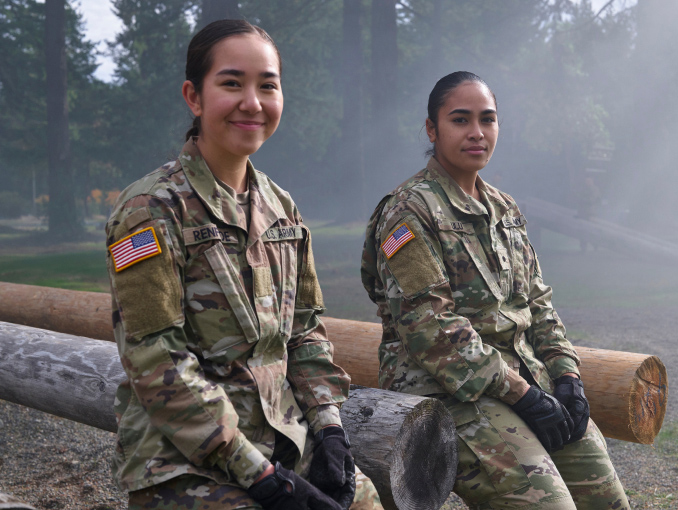
Scholarships and other monetary support are available to help with costs when you join Army Reserve Officers’ Training Corps (ROTC). Focus on your education and graduate into a secure path as an Army Officer—and with less debt for the school years your scholarship covers. You’re eligible if you are a high school student enrolling in college, enrolled in college, or an active-duty enlisted Soldier.
Reach your financial goals.

Get tuition and fees covered.
Get the full college experience, only with less debt, in exchange for a career serving in the Army as an Officer after graduation. ROTC scholarships are awarded based on academic achievements and can be applied to any of the 1,000+ participating schools, covering either tuition and fees or room and board.
Get money for expenses and books.
Receive monthly help to offset living and book costs. All ROTC scholarships include an extra $420 each month throughout the school year for expenses like housing, along with $1,200 each year to spend on books.
Apply in high school or college.
You’re eligible to apply for an Army ROTC scholarship at a participating school upon completion of your junior year of high school or as a college student.
High School
Here’s what to know when applying for an ROTC scholarship in high school.
Start the application process.
To get started on your ROTC scholarship application, create an account and log in to the Scholarship Application. From there, you’ll locate and contact the Recruiting Operations Officer at the school you plan to attend. Most of them have served before and understand the process you’re going through.
Important dates to remember
ROTC scholarship applications opened on June 12, 2023. Applications must be started no later than March 4, 2024 to be eligible for review by the Army ROTC National Scholarship Board for the 2024 – 2025 school year.
Due October 9, 2023
Applications will be reviewed from October 16 – 20, 2023.
Due January 15, 2024
Applications will be reviewed from January 22 – 26, 2024.
Due March 11, 2024
Applications will be reviewed from March 18 – 22, 2024.
Your obligation with an ROTC scholarship
Your acceptance of the ROTC scholarship means a future service obligation of eight years in the Army, with requirements for active duty and/or the Army Reserve or Army National Guard depending on the scholarship. You may be eligible to serve part time in the Army Reserve or Army National Guard while pursuing a civilian career immediately after graduation.
Scholarship recipients who wish to exit the ROTC program may do so after their freshman year of college without any obligation.
Here’s what to know when applying for an ROTC scholarship in college.
Types of scholarships available.
You’ll have access to four-year, three-year, or two-year scholarships if you decide to join Army ROTC as a college student. Four-year scholarships are most common for students who are on a five-year college plan, while two-year scholarships are more common for those who attend certain participating two-year community colleges before transferring to a four-year university.
To get started on your ROTC scholarship application, locate and contact the Recruiting Operations Officer at your school to discuss how to apply. Most of them have served before and understand the process you’re going through. Their years of experience will help the process.
Scholarship recipients who wish to exit the ROTC program may do so after their freshman year of college without any obligation.
Requirements to be eligible for an ROTC scholarship.
To be accepted for any ROTC scholarship, you must meet these standards.
Be a U.S. citizen.
Be at least 17 and under 31 in year of commissioning.
Have a high school diploma or equivalent.
Have an unweighted high school GPA of at least 2.50 if you’re in high school while applying.
Have taken the SAT or ACT.
Take the Army Combat Fitness Test (ACFT) .
Meet the physical weight and height requirements .
Agree to accept a commission and serve in the Army , Army Reserve , or Army National Guard .
Career-building scholarship programs
Nursing scholarships.
Nursing students can apply for any Army ROTC scholarship by following the directions above. Being a nurse in the Army provides you with opportunities not found in the civilian world, including a three-week paid Nurse Summer Training Program, which introduces students to the Army Medical Department and the roles and responsibilities of an Army Nurse Corps Officer .
Enlisted Soldier Scholarships
As an enlisted Soldier, you have access to the Green to Gold program and scholarship opportunities to cover costs for tuition or room and board, while you earn your undergraduate or graduate degree.
TAKE THE FIRST STEP.
Get In Touch
You have no saved jobs.
Take a short quiz or explore more than 200 jobs that might interest you.
Tell us about yourself.
All fields are required.
Activity Title:
GoArmy Title:
Now, who referred you?
Fill in the first and last names of the person who referred you, along with their Department of Defense identification number (DoD ID #) for proof of service and phone number if they want to receive status updates. Their information is protected and maintained by the Privacy & Security Notice
Answer True or False to the following statements based on your current situation (optional).
Find rotc programs at schools you’re most interested in..
Privacy Act Notice: The above disclosure is voluntary. All information will be used strictly for recruiting purposes. The authority for the collection of this information is Title 10, United States Code, Sections 503, 505, 508, and 12102, and EO 9397. For more information, please review our Privacy & Security Notice.
Recent entries.
Give us a call
Contact your local recruiting office with any questions.

IMAGES
VIDEO
COMMENTS
Types of High School Essay. 1. Narrative Essay. Narrative essays tell a story from the writer's perspective, often highlighting a personal experience or event. The focus is on storytelling, including characters, a setting, and a plot, to engage readers emotionally.
Essay Sample: Introduction The transition from high school to university marks a significant milestone in a student's life. Both high school and university offer ... Students looking for free, top-notch essay and term paper samples on various topics. Additional materials, such as the best quotations, synonyms and word definitions to make your ...
See how to build a well-structured essay with an effective introduction, focused paragraphs, clear transitions, and a strong conclusion. ... The Royal Institute for Blind Youth in Paris taught the students to read embossed roman letters, a method created by the school's founder, Valentin Hauy (Jimenez et al., 2009). Reading this way proved to ...
This will give you a firsthand example of how writing in high school vs. college can differ. 2. Analysis Emphasized More Than High School Writing. Most high schools do not emphasize heavy research, analysis, or innovation in a given topic. University courses will usually demand a lot of depth. This can be very challenging for some students who ...
There are many types of essays you might write as a student. The content and length of an essay depends on your level, ... most essays at university level are argumentative ... On average, the body comprises 60-80% of your essay. For a high school essay, this could be just three paragraphs, but for a graduate school essay of 6,000 words, the ...
Here are some important differences between high school rules and university expectations: High School Rules University Expectations; ... An essay that addresses counter-arguments becomes stronger and more persuasive by acknowledging the complexity of the material. Presentation. Students may receive credit for visual effects.
ESSAY WRITING PARAGRAPH WRITING TIPS. Each paragraph should focus on a single main idea. Paragraphs should follow a logical sequence; students should group similar ideas together to avoid incoherence. Paragraphs should be denoted consistently; students should choose either to indent or skip a line.
I could see the horizon again. 2. Narrative Essay. A narrative high school essay is similar to a descriptive essay but focuses more on the story description rather than the object description. The story can be about a personal experience that the writer has had, an event, a story, or an incident.
Supported by the outcomes of identified effective learning strategies, University of Toronto (U of T) graduate trainees created a novel high school education program Discovery, to develop a ...
1. Hook the readers with a relevant fact, quote, or question for the first sentence. An attention getter draws readers into your essay. Use a shocking statistic or a hypothetical question to get the reader thinking on your subject. Make sure not to use an attention getter unrelated to the topic of your essay.
This essay will explore the importance of college education after high school, emphasizing its role in enhancing career prospects, personal growth, and societal contributions. By delving into these aspects, it becomes evident that college education is not just an option but a valuable investment in one's future.
In contrast, high school students just have to follow the rules and obey their teachers. Second, high school students usually have more fun than university students. Their lives are notso serious. They are more carefree and they do more fun ac/vi/es. University students, however, oQen don't have much free /me.
High School Essay vs College Essay. 1. Understand Purpose. A high school essay generally demonstrates to your teacher what you know. An application essay should demonstrate who you are. Colleges want to find out what you're passionate about, and what you would add to the campus community. 2.
New York University College of Arts and Science Scholarship by Ana. Award amount: $39,500. Essay prompt: Explain something that made a big impact in your life. Why it was successful: Ana discussed how early experiences w ith learning difficult things has contributed to her passion for teaching and supporting students.
Essays Every High School Student Should Read. December 4, 2016 in Pedagogy. One of the most important goals of any English class should be to help students learn how to express themselves to an audience — how to tell their own stories, how to provide much-needed information, and how to convince others to see things from a different perspective.
Answers. 1. There are many methods of learning and many ways to develop student's skills. 2. They have to be more responsible, independent and they have make decisions by themselves. 3. Life can be fun and carefree. 4. They live in small narrow worlds with similar people with similar ideas.
College essay example #1. This is a college essay that worked for Harvard University. (Suggested reading: How to Get Into Harvard Undergrad) This past summer, I had the privilege of participating in the University of Notre Dame's Research Experience for Undergraduates (REU) program .
A good narrative essay will begin with an attention-grabbing opening line. But make sure to avoid common clichés, such as "It was the best of times, it was the worst of times.". Instead, come up with something original and specific to you and your situation. For example: "My pre-calc teacher was obsessed with circles.
The following ideas work well for compare-contrast essays. ( Find 80+ compare-contrast essay topics for all ages here.) Public and private schools. Capitalism vs. communism. Monarchy or democracy. Dogs vs. cats as pets. WeAreTeachers. Paper books or e-books. Two political candidates in a current race.
It's a good idea to prepare to write this essay at least three times. First, there's a rough draft that should be carefully proofread. Students can ask a teacher or other professional to also look at their paper. Then students should repeat this process once or twice more until they're happy with the results.
[+] University campus on June 29, 2023 in Cambridge, Massachusetts. The U.S. Supreme Court ruled that race-conscious admission policies used by Harvard and the University of North Carolina violate ...
Three years ago, a program to provide Louisiana high school students with free SAT and ACT prep courses, essay writing workshops and other programs to prepare them for college attracted eight students from four parishes. Fast-forward to today and that program — the Louisiana Center for College Access (LCCA) — has provided college access support to 6,049 high school students from 63 parishes.
Review First-Year Admission Requirements. Regionally Accredited High School Students. GED Students. Home-Schooled Students. Non-Accredited High School Students. Students with Fewer than 14 Transferable Credits. Discover the admission requirements for first-year applicants at University of Idaho. Your path to academic excellence starts here.
Mission. The Purdue On-Campus Writing Lab and Purdue Online Writing Lab assist clients in their development as writers—no matter what their skill level—with on-campus consultations, online participation, and community engagement. The Purdue Writing Lab serves the Purdue, West Lafayette, campus and coordinates with local literacy initiatives.
Citizenship is also part of the university core functions of teaching, learning and research. Citizenship happens when students are willing to act beyond their self-interests, even if personal and communal interests often overlap. Citizenship happens when students engage with peers and the teachers, in activities they don't get paid for or ...
To be accepted for any ROTC scholarship, you must meet these standards. Be a U.S. citizen. Be at least 17 and under 31 in year of commissioning. Have a high school diploma or equivalent. Have an unweighted high school GPA of at least 2.50 if you're in high school while applying. Have taken the SAT or ACT.
Worth between $1,000 and $15,000. NSHSS James W. Lewis High School Global Leader Scholarship - For high school students who have displayed leadership. Worth $5,000. Breakthrough Junior Challenge - For students aged 13 to 18 who create a video to explain a scientific or mathematical concept. Worth $250,000.
Secondary essays vary in length and number. Vanderbilt requires applicants to submit an 800-word essay and two 600-word essays. Some schools may require close to 10 secondary essays. Shemmassian ...
The 2023-2024 yearbook for East Brunswick High School in New Jersey replaced a photo of the Jewish Student Union (JSU) with Muslim students and erased the names of the JSU members.
Editor's Note: This story is part of an occasional series on research projects currently in the works at the Law School. The Supreme Court's decision in June 2023 to bar the use of affirmative action in college admissions raised many questions. One of the most significant is whether universities should consider applicants' discussion of race in essays. The Court's decision in Students ...